Foundation of Black Wagyu, Red Wagyu/Akaushi that were exported from Japan
A total of 167 Black Wagyu is known to have been exported. 21 calves registered from Japanese AI sires were born after the arrival of the heifers. 16 Red Wagyu/Akaushi bulls and heifers were exported and 6 registered births resulted. A total of 221 Wagyu cattle brought genetics from Japanese Black and 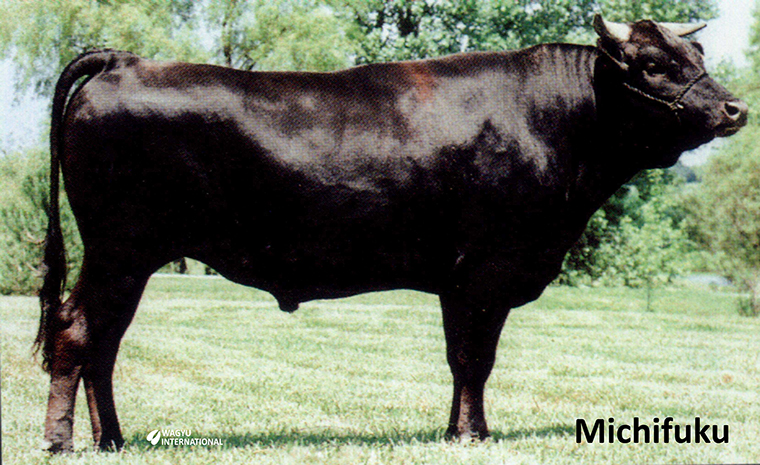 Japanese Brown and they formed the basis of all Wagyu and Akaushi in USA, Canada and Australia. The second migration from those countries commenced globally from the late 1990s to Europe, South America then South Africa. Finally, herds have become established across the Pacific and Asia.
Japanese Brown and they formed the basis of all Wagyu and Akaushi in USA, Canada and Australia. The second migration from those countries commenced globally from the late 1990s to Europe, South America then South Africa. Finally, herds have become established across the Pacific and Asia.
Four bulls were sent from Japan by Morris Whitney in 1976. Colorado University took semen collections then they were bought by Wagyu Breeders Inc. There were no Wagyu females in America so the original two Wagyu Black (Mazda from Tottori and Mt Fuji from Hyogo) and two Wagyu Red bulls (Rueshaw and Judo from Kumamoto) were joined to Angus, Holstein, Hereford and Brangus cows in Texas. By 1991 the highest percentage Wagyu bull in the USA was 63/64 and it was estimated that there were less than 300 Wagyu crossbred females of breeding age that were 3/4 Wagyu or higher. In about 1991 the narrow genetic base was widened when semen from the fifth bull Itotani was brought to Canada by Lakeside Industries at Brooks. In the fourth generation, the American Purebred (15/16) is obtained and contains 93.75% Wagyu genetics.
The Mannett Group (later to become World Ks) imported three Black Wagyu females (Suzutani and Rikitani - both Tajima - and Okutani - 75% Tajima and 25% Shimane) and two bulls (Michifuku and Haruki 2) in 1993. The first Fullbloods to be born outside Japan were the second generation embryos sired by Haruki II. Rikihari in Canada was the first on 19th June 1994 from Rikitani, then Genjiro from Okutani on 23rd June, with Okuharu following on the next day. The first Fullblood calf to be born in USA was Fujiko with her brother Beijirou from Okutani, also on 24th June 1994. Later in the year the first live exports were transported from USA to Wally Rae in Australia.
The Mannett Group imported four black females (Okahana, Nakayuki, Kanetani and Nakagishi 5) and two black males (Kenhanafuji and Takazakura) in 1994. Calves born after arrival were Tanitsuru, Nakazakura, Kitaguni Jr and Reiko.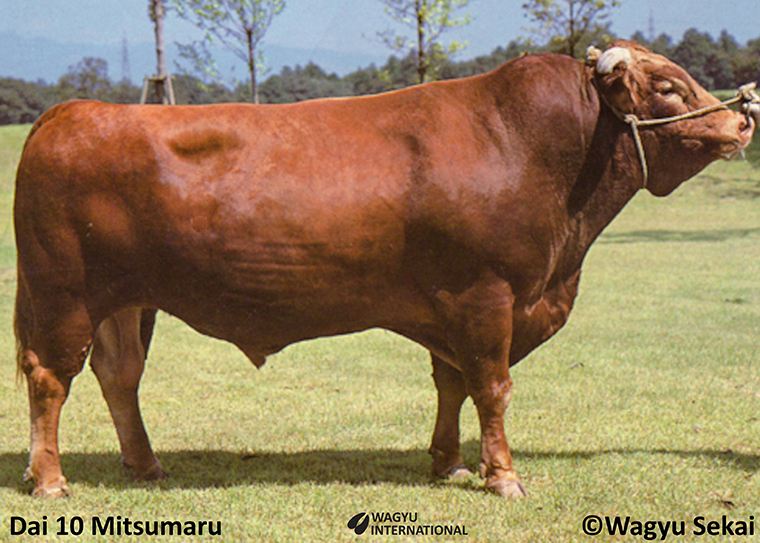
In this consignment were Red Wagyu imported by Dr Al and Marie Wood from selections made by Mr Yikio Kurosawatsu and Dr King in Kumamoto Prefecture. Nine red females (Namiko, Ume, Namoi, Akiko, Haruko, Fuyuko, Dai 3 Namiaki, Dai 9 Koubai 73 and Dai 8 Marunami) and three red bulls (Shigemaru, Tamamaru and Hikari) are registered. Calves born to AI (from Japanese sires Namimaru and Dai 10 Mitsumaru) were Big Al, Kaedemaru, Momigimaru, 504 and 505. After the 180 days incubation that was required for quarantine, Namoi, Dai 3 Namiaki, Kaedemaru and Momigimaru went to Ontario in Canada. The remainder of the Red Wagyu/Akaushi herd in USA was sold to Englewood Farm in Texas. Subsequently most were transferred domestically to HeartBrand, also in USA, to form what became one of the biggest Red Wagyu/Akaushi herds outside Japan.
Japanese Venture Partners imported three black bulls (Kikuyasu, Fukutsuru, Yasutanisakura), ten black females (Chisahime 662, Chiyofuku 992, Fukutomi 990, Kikuhana 298, Shigehime 208, Tokuhime 486, Yasufuji 1/4, Yoshifuku 2 and Yuriko 1), and two red heifers (Kunisakae and 27 Homare).
Mr Shogo Takeda exported 35 black females, many in calf, and five black bulls (Itomichi 1/2, Kikuhana, Itohana 2, Kinto and Terutani) in 1994.
Mannett imported 7 black females (Taguchi 9, Nakahana 5, Mitsutaka, Okuito 9, Hanateru 9, Rabito and Hisako) with one black bull (Yasufuku Jr) in 1997.  Calves were Taguchifuku, Kotomichan and Kousyun.
Calves were Taguchifuku, Kotomichan and Kousyun.
Chris Walker of Westholme imported 25 black females and three black males (Hirashigetayasu, Itomoritaka and Kitateruyasu Doi) to USA from ET Japan Company in Hokkaido in 1997. The following year another 59 females arrived together with semen from three black bulls (Shigefuku, Dai 6 Seizan and Kitatsurukiku Doi). Out of the 84 females, 63 were pregnant. The bulls 001, 002 and 003 were used heavily in Australia and the females were exported to Australia while 004, 005 and 006 were used more heavily in USA. This consignment was diverse with 44 Shimane and 28 Kedaka with 12 Tajima so injected milk and size with marbling. Dams which bred in Australia include: Hatsuko, Itoreiko, Kazuaki, Kitahikari 97/1, Kitakazu, Kitaokumi, Kitasakaedoi, Kitasekitori, Kitatizuru 2, Kunikiku 96, Masako, Masatoshi 2, Sakaehikari, Sekinakada 22, Sekiyuhou, Takakuni, Takashigedoi, Yamafuji, Yamaketakafuji 3 and Yuriyuhoi.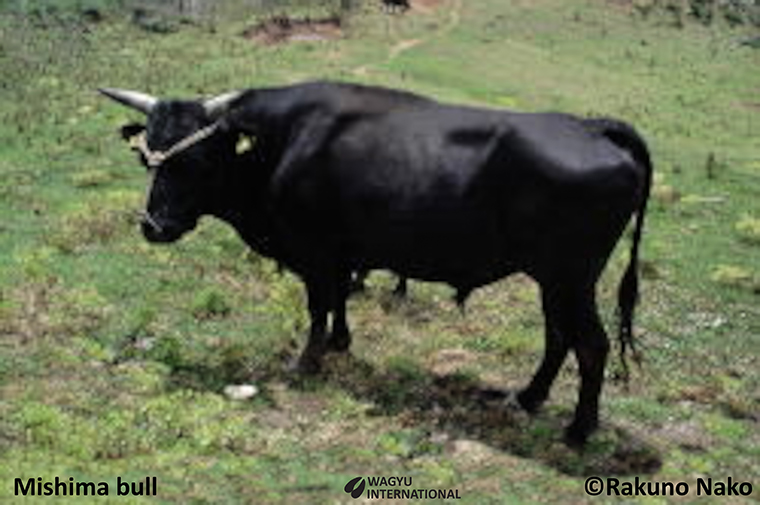
Takeda Farms imported 6 black bulls (Kikutsuru Doi, Itoshigefuji, Itoshigenami, Mitsuhikokura, Kikuterushige, Itozuru Doi). After the quarantine period in USA, the Takeda herd was dispersed to Australia and Canada.
A Mishima bull (Kamui) - a native cattle breed from Mishima Island - was in this consignment. The indigenous cattle population on Mishima Island had been eliminated by Rinderpest disease in 1672. A few Japanese Black were transported over from mainland Japan to re-establish the herd, which has been in-bred for more than 25 generations. Mishima has high marbling but is smaller than the conventional Wagyu breeds of today. Kamui is registered as a Base animal (B115 with date of birth 28th August, 1991) to enable crossing with Wagyu. His progeny out of registered Fullblood dams are registered as Wagyu percentage (50% Wagyu) by the American Wagyu Association.
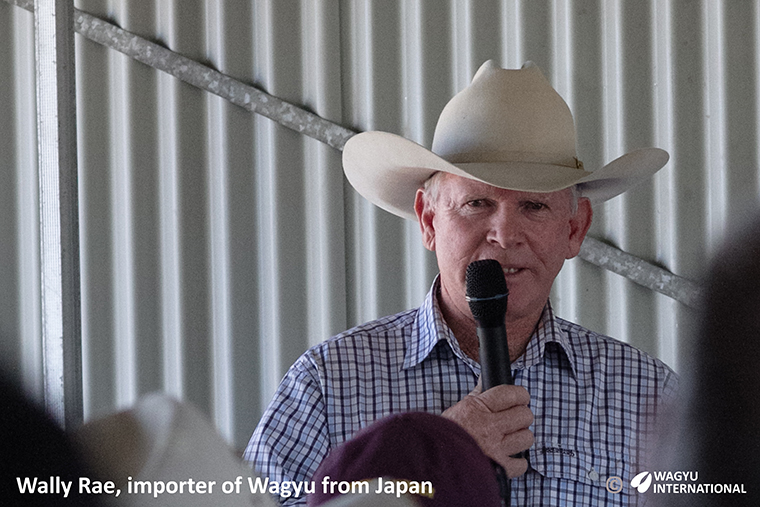
The names of bulls, heifers and calves that were imported or inseminated from Japanese parents are tabled:

Simon Coates of Sumo Wagyu in Australia imported 56 calves as embryos from Shogo Takeda's first consignment. This included six bull calves:
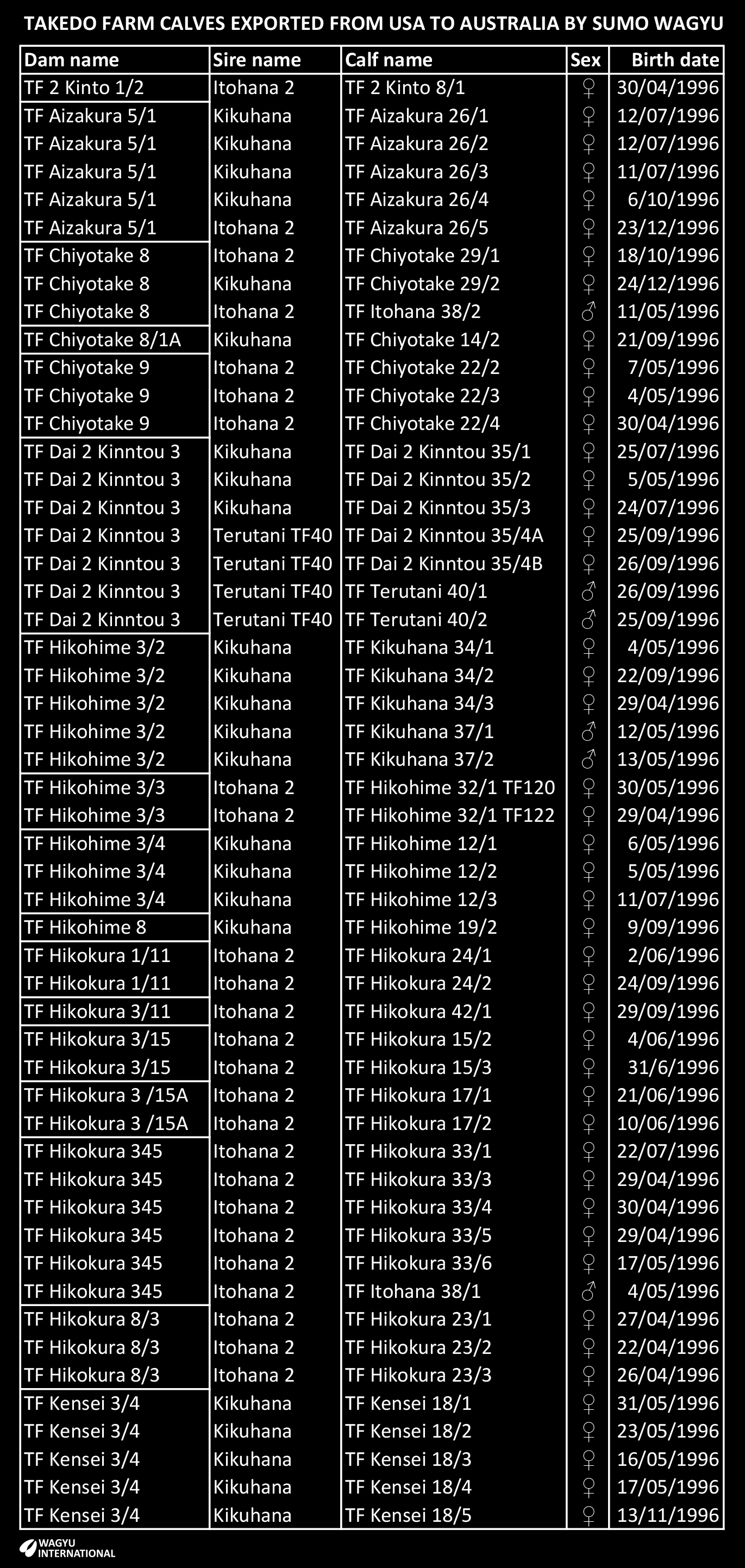
Two heifers sired by Kikuhana for Sumo Wagyu in Australia out of Itomichi sired Foundation heifers from Shogo Takeda exports of 1995 are illustrated below.
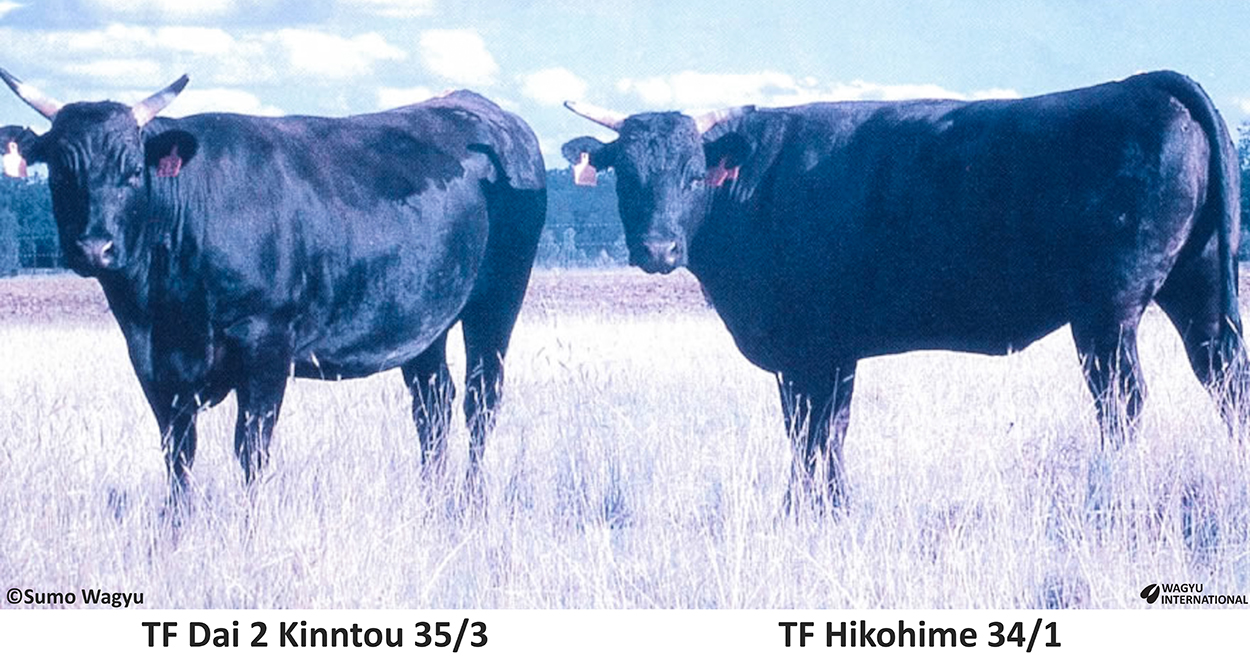
![]()
Dr Simon Coates also bought the Australian herd from Mr Takeda to complement the embryos that he had imported from six families. Together with Takeda Farm semen they formed the basis of his herd and the industry throughout Australia. The Takeda herd in USA was sold to Mr Gary Yamamoto in Canada.
Number of registrations of progeny from Foundation sires
The number of registered progeny from Foundation sires in the Australian Wagyu Association and American Wagyu Association herdbooks in August 2020:
| FOUNDATION NAME | AUSTRALIA | USA |
| Dai 6 Seizan | 237 | 9 |
| Eikichi | 174 | 11 |
| Fukutsuru | 1,000 | 391 |
| Haruki 2 | 1,665 | 582 |
| Hirashigetayasu '001' | 3,246 | 643 |
| Itohana 2 | 3,014 | 274 |
| Itomichi 1/2 | 1,136 | 629 |
| Itomichi 42 | 149 | 0 |
| Itomoritaka '002' | 1,551 | 284 |
| Itoshigefuji 'TF147' | 4,168 | 232 |
| Itoshigenami 'TF148' | 6,220 | 619 |
| Itozurudoi 'TF151' | 2,632 | 272 |
| Kenhanafuji | 403 | 128 |
| Kikuhana | 538 | 328 |
| Kikuterushige 'TF150' | 1,142 | 61 |
| Kikutsurudoi 'TF146' | 40 | 39 |
| Kikuyasu | 611 | 511 |
| Kinto | 147 | 60 |
| Kitaguni Jr | 489 | 452 |
| Kitateruyasudoi '003' | 4,101 | 245 |
| Kitatsurukikudoi | 265 | 1 |
| Michifuku | 5,597 | 582 |
| Kitatsurukikura 'TF149' | 97 | 125 |
| Shigefuku | 289 | 196 |
| Takazakura | 355 | 206 |
| Terutani TF40 | 580 | 131 |
| Yasufuku Jr | 908 | 444 |
| Yasutanisakura | 129 | 114 |
| Yukiharunami 4 | 882 | 3 |
| TOTAL | 41,765 | 7,572 |
The four most popular Foundations sires account for 48% of total registrations in Australia - being Itoshigenami TF148, Michifuku, Itoshigefuji TF147 and then Kitateruyasudoi "003". In USA, the four most popular Foundation sires are Hirashigetayasu "001", Itomichi 1/2, Itoshigenami TF148 and then Michifuku with 35% of the total.
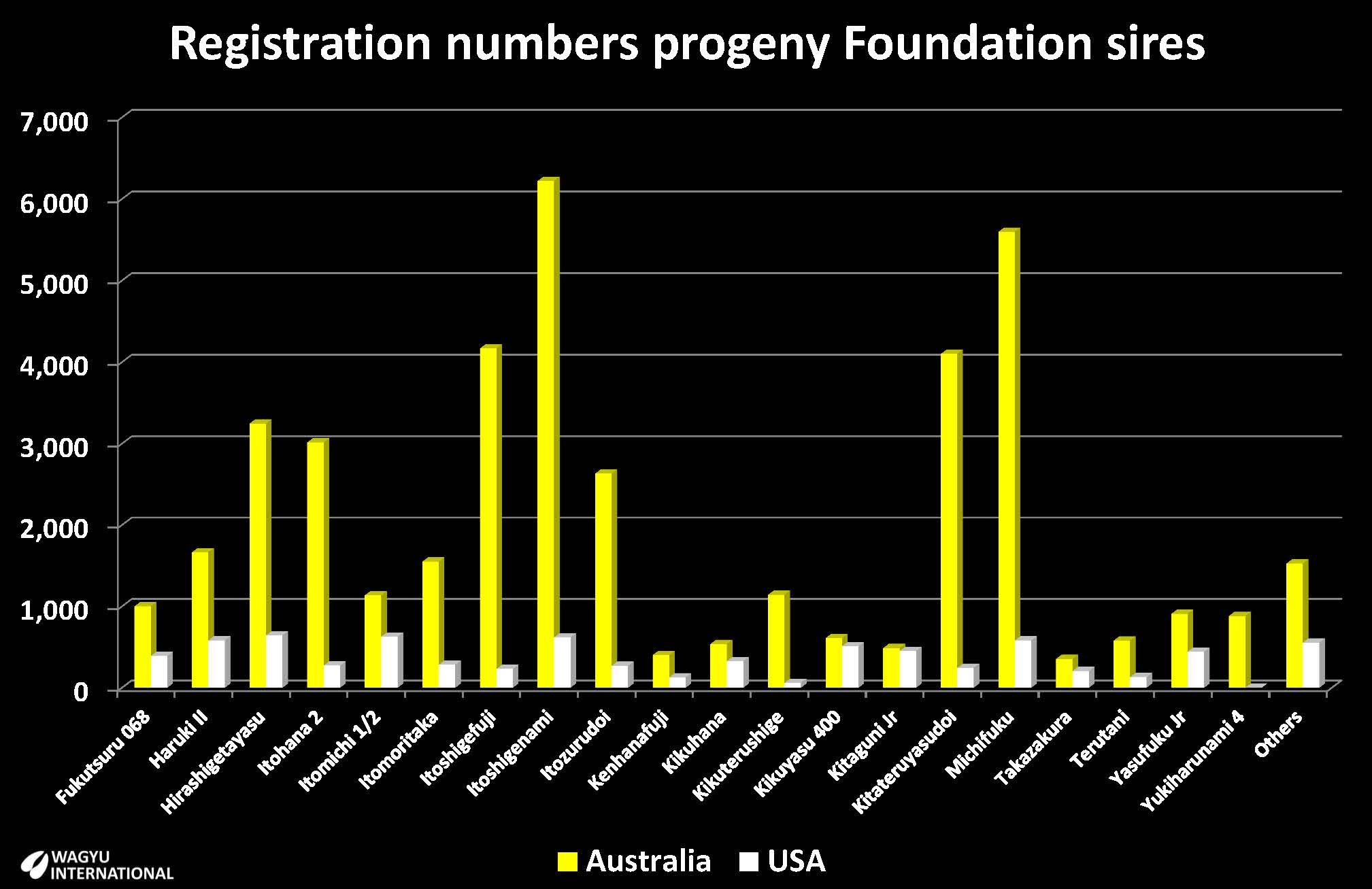
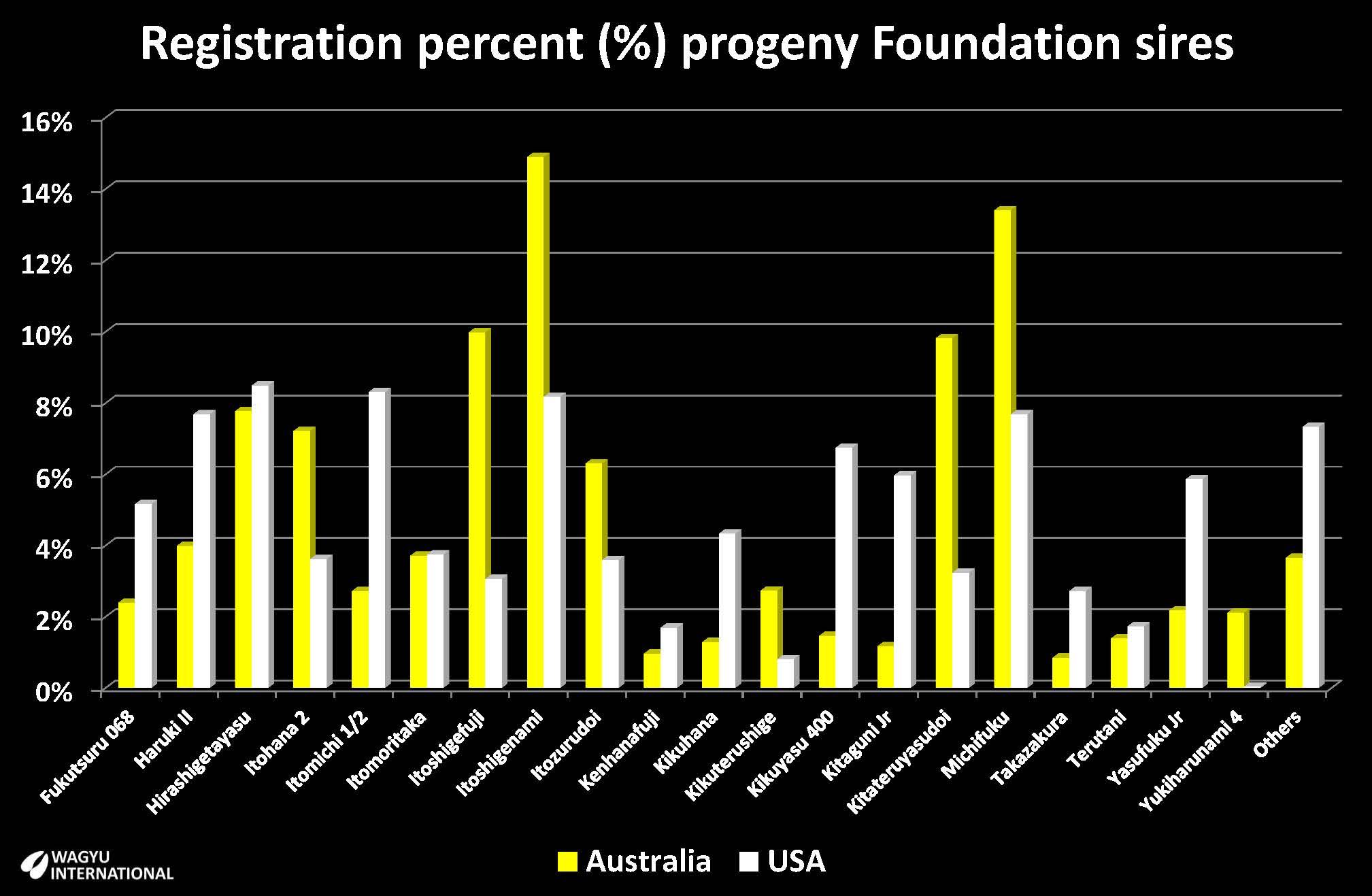
Performance data from progeny
Generally Wagyu in Australia are finished through lotfeeding at a fixed age or target weight after backgrounding on pastures. Marketing occurs at a predetermined slaughter weight for the most economic return for each operation after an average of 450 days for Fullblood steers at a HSCW of 430 to 460 kg.
A boutique feedlot is run by Blackmore Holdings where days on feed are variable so some of their production data from progeny from Foundation provides interesting insight into the influence from sires. Induction is at a fixed age but slaughter was from 510 to 793 days on feed with a weighted average of 620 days on feed. After induction at the Japanese standard of ten months of age, with an average live weight of 284 kg, slaughter is estimated to be at an average between 26 to 36 months of age per sire, with an average of 30 months of age. The premium earned by Blackmore Holdings justifies such long feeding times but they are not viable for most commercial operations.
The live weights, growth rates and estimated age at slaughter are presented in the table:
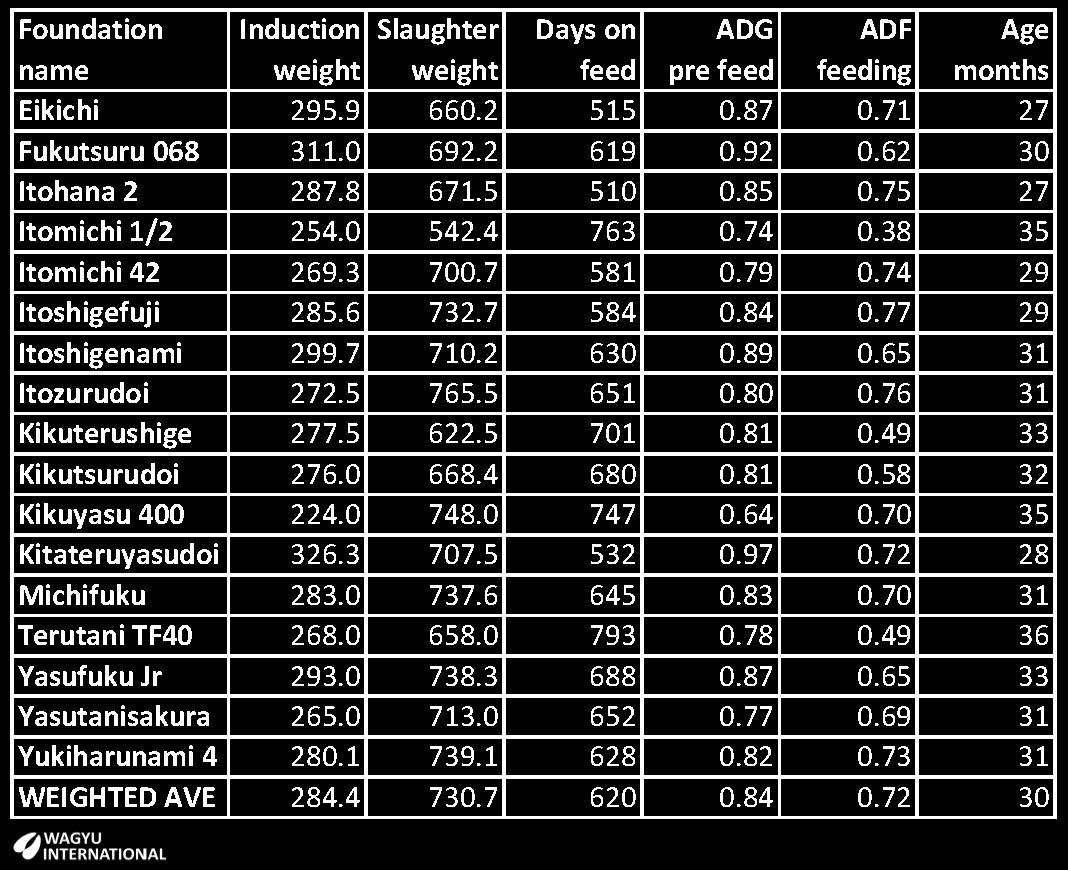
Progeny data from the most prolific sires have been analysed and presented in a chart to show live weight by age at induction and at slaughter.
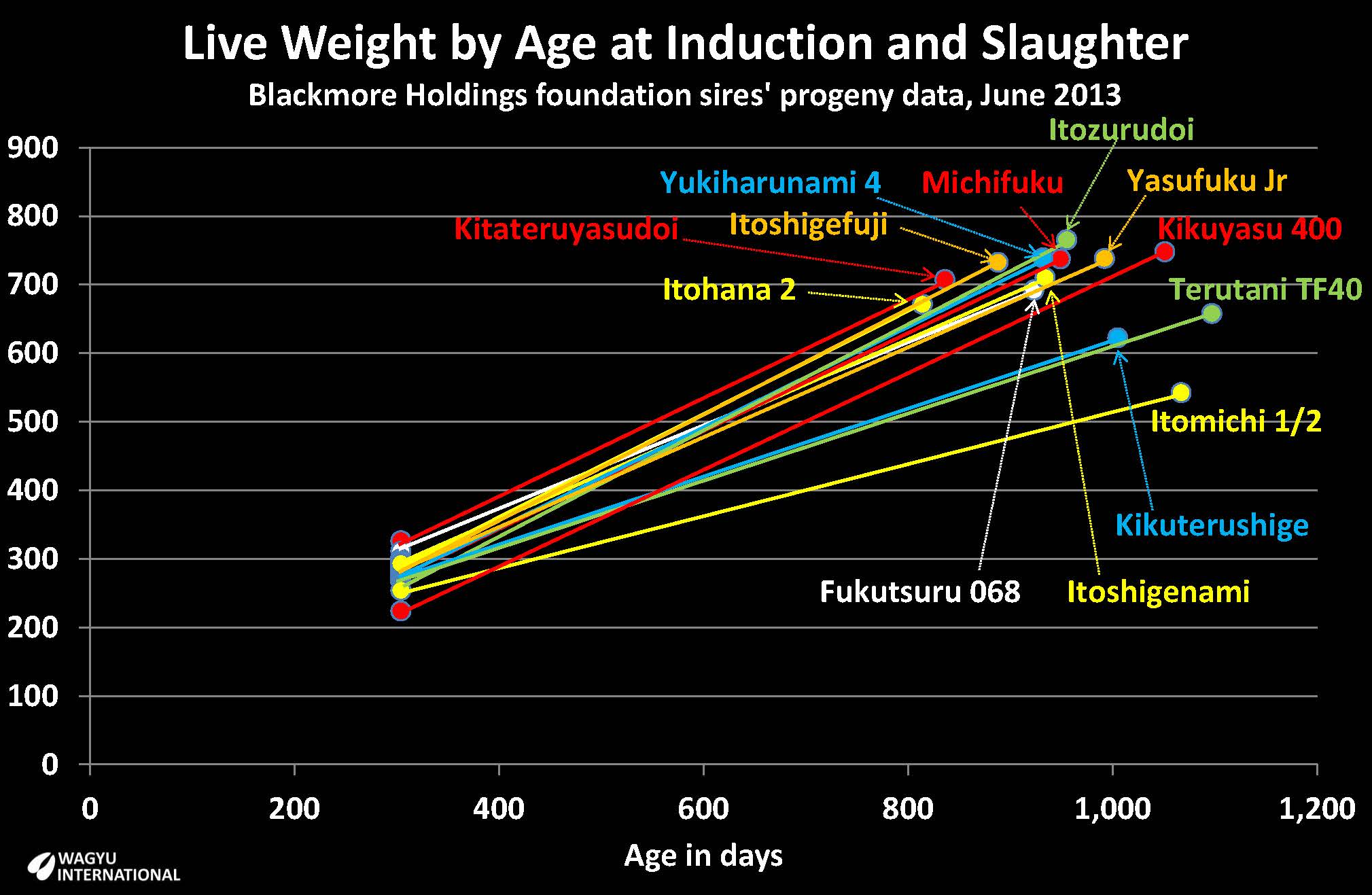
The lightest induction weights of 224kg are from Kikuyasu 400 and the heaviest induction weights are the average of 326.3kg from 51 progeny from Kitateruyasudoi "003".
The extensive spread in days on feed from 16.8 months for progeny from Itohana 2 to the longest of 26.1 months for progeny from Terutani TF40 is illustrated. The lighest average HSCW is 383.1kg for Fukutsuru after 20 months on feed and the heaviest average is 457kg from progeny of Itozurudoi TF151 after 21.4 months on feed with a slaughter weight of 765.5kg. The very diverse weight range of 102.3kg (36%) at induction has been narrowed to 73.9kg (10%) by the extension of 10 months to the time on feed.
Carcass results are presented. IMF% was not recorded by Blackmore but the percentage of progeny that graded AUS-MEAT Marble Score 9 or above and the percentage that graded 9+ was given to show which sires reach highest marbling scores:
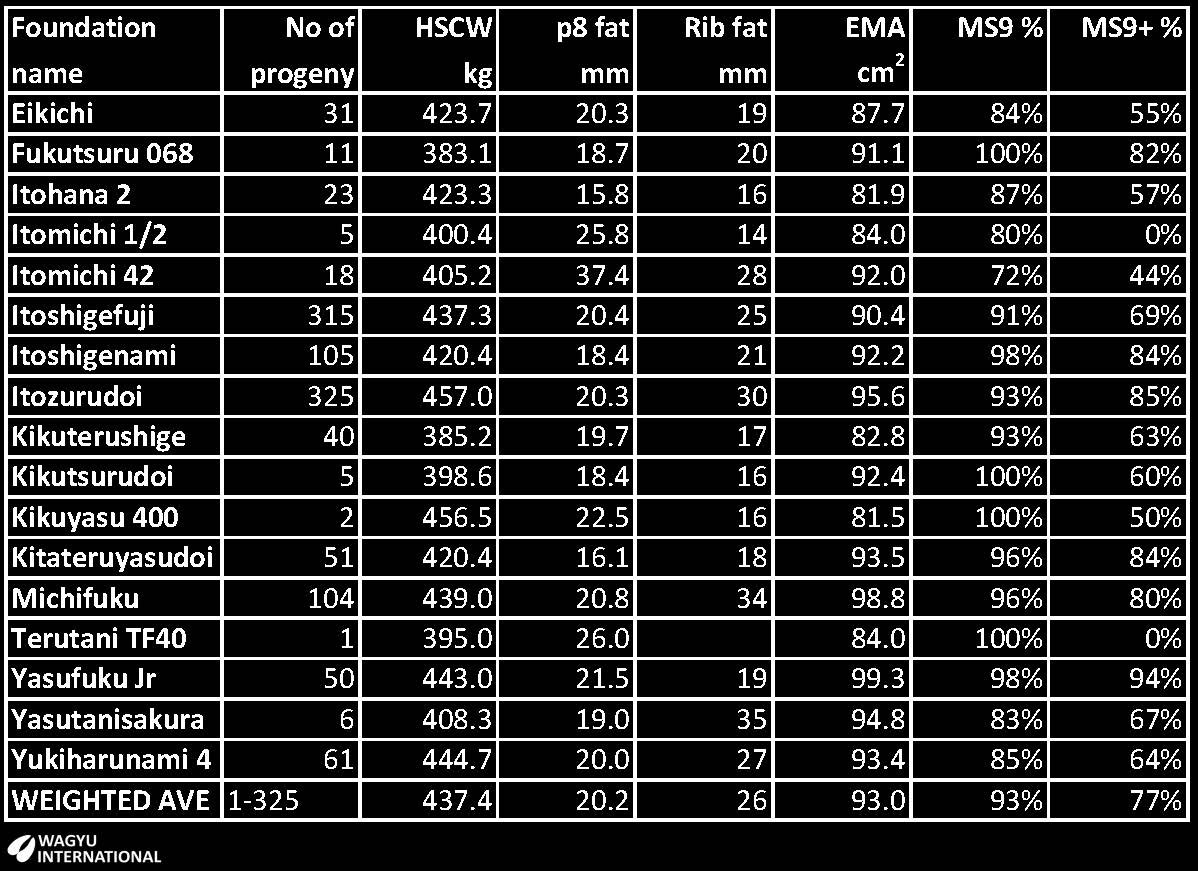
Only eight sires (or half) had 40 or more progeny so influences from dams would be expected to influence averages in this table for about one half of the sires because of the low numbers. Nevertheless, some interesting data is shown here from some of the previously less popular Foundation sires. Due to concerns about sustainability within the narrow gene base of the Wagyu breed there is renewed interest in some old genetics.
Associations were checked with genomic estimated breeding values (gEBV) as reported by Blackmore Holdings and against single step gEBVs from Australian BREEDPLAN. Relatively low correlations indicate that performance data from fewer than 40 Fullblood progeny are not reliable measures of genetic merit of a parent - except possibly for HSCW and EMA. A BLUP analysis is required to eliminate environmental influences and the contribution from the other parent.
Correlations between subcutaneous fat thickness and gEBVs were low but some associations were found between backfat and other data. There was a negative association between P8 and induction live weight and with marble score. In some commercial grids, there is a price penalty for P8 thickness below 12mm and for thickness that exceeds 31mm. The only sire with progeny that averaged above the penalty thickness for P8 in Blackmore's data is Itomichi 42.
Heritability is reduced for Marble score using AUS-MEAT graders and Ben Hayes described at an AWA conference in 2017 that he found from his analysis of the Blackmore genomic data that the validation accuracy for Marble Score was 0.43 because of the limitations from AUS-MEAT for marbling. It was 0.71 for carcass weight, 0.57 for eye muscle area and 0.46 for P8 fat.
In my opinion, in most commercial production systems, the early age of slaughter is too young before full genetic potential can be expressed so this dataset is very useful to see performance through to 36 months in some progeny groups that require a longer time on feed. Japanese Black were found to continue to marble between 30 and 34 months of age so there are benefits from extended feeding times for Wagyu that have the strongest ability to marble but those that lack marbling should be processed when there is sufficient fat content for optimum eating quality.
Genomics from leading Black Wagyu Foundation sires
The following illustration gives a quick comparison of economic production traits for the leading Founders of the Black Wagyu population:
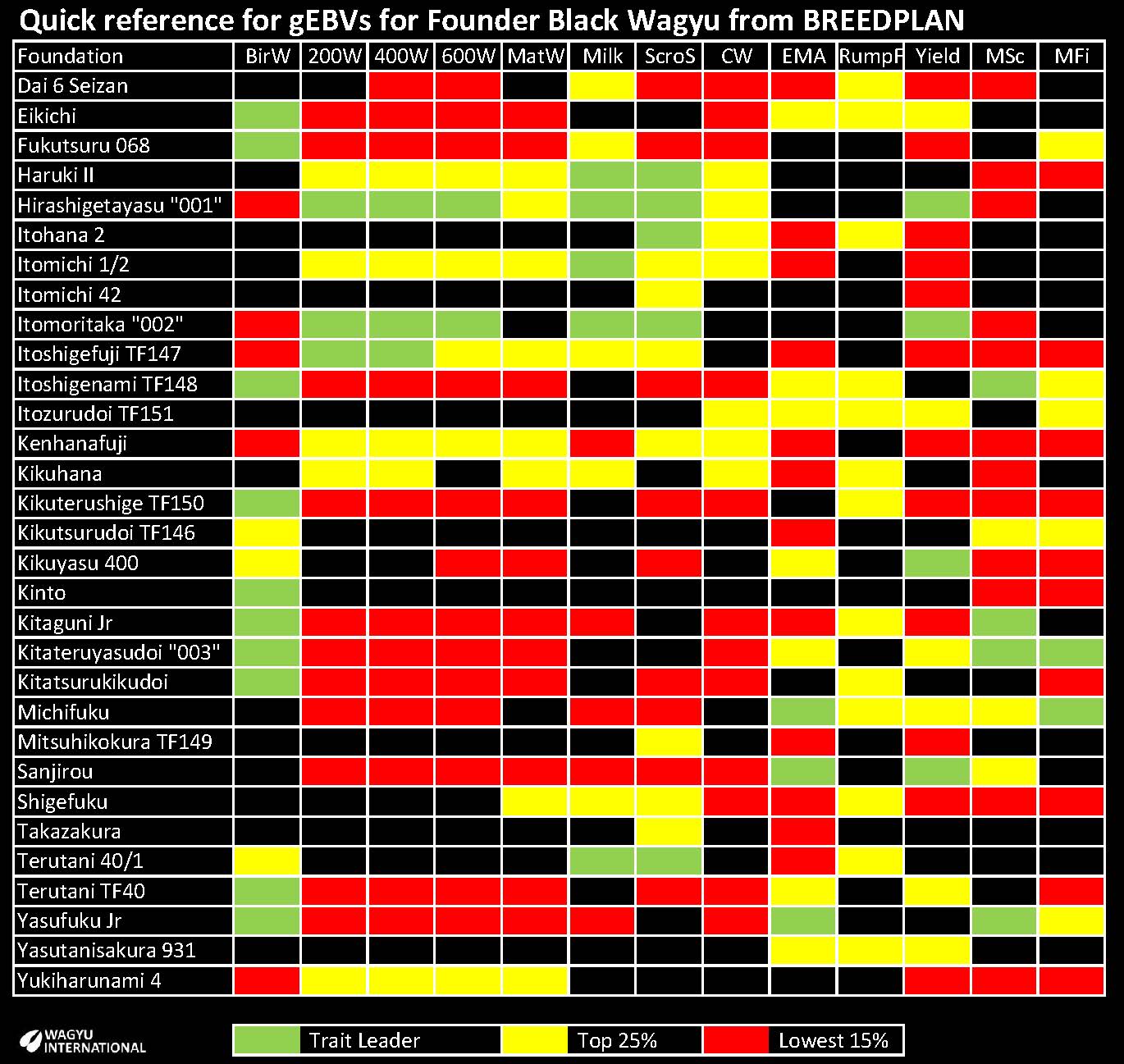
The Trait Leaders are shaded in green and the gEBVs that are within the Top 25% of the Australian BREEDPLAN run of August 2020 are in yellow. Traits that are in the Lowest 15% of the population are shown in red.
Examples of genomic estimated breeding values (gEBV) for leading foundation sires:
The genomic EBVs are a powerful breeding tool for the Wagyu industry outside Japan. BreedObjective $Indexes are published on the Australian Wagyu Association website and they are called the Wagyu Breeder Index, Self Replacing Index, Fullblood Terminal Index and the F1 Terminal Index. They fulfill a valuable tool for the Australian Wagyu industry.
While working with colaborator herds on nutrition for Wagyu that are finished on pastures, Wagyu International has developed a Grain finishing and a Grass finishing score. EBVs are weighted so that ranking can be made for either Grass or Grain finishing. Criteria that were evaluated are growth rate during backgrounding and finishing, carcass traits, feed intake and retail value. Animals are ranked against the industry so the range is from a score of -50% to the best with +50%. Economic EBVs that contribute to Carcass and Maternal performance and weughted to give a Carcass score and a Maternal score.
The gEBVs for the Foundation sires with the highest number of registered progeny are illustrated in charts below. Maternal traits are ramnked against the industry on the left side of each chart and Catcass traits are on the right. The Grass and Grain finishing scores are the light green bars in the middle of ech chart. Next to each of them are the Maternal and Carcass scores in white bars.
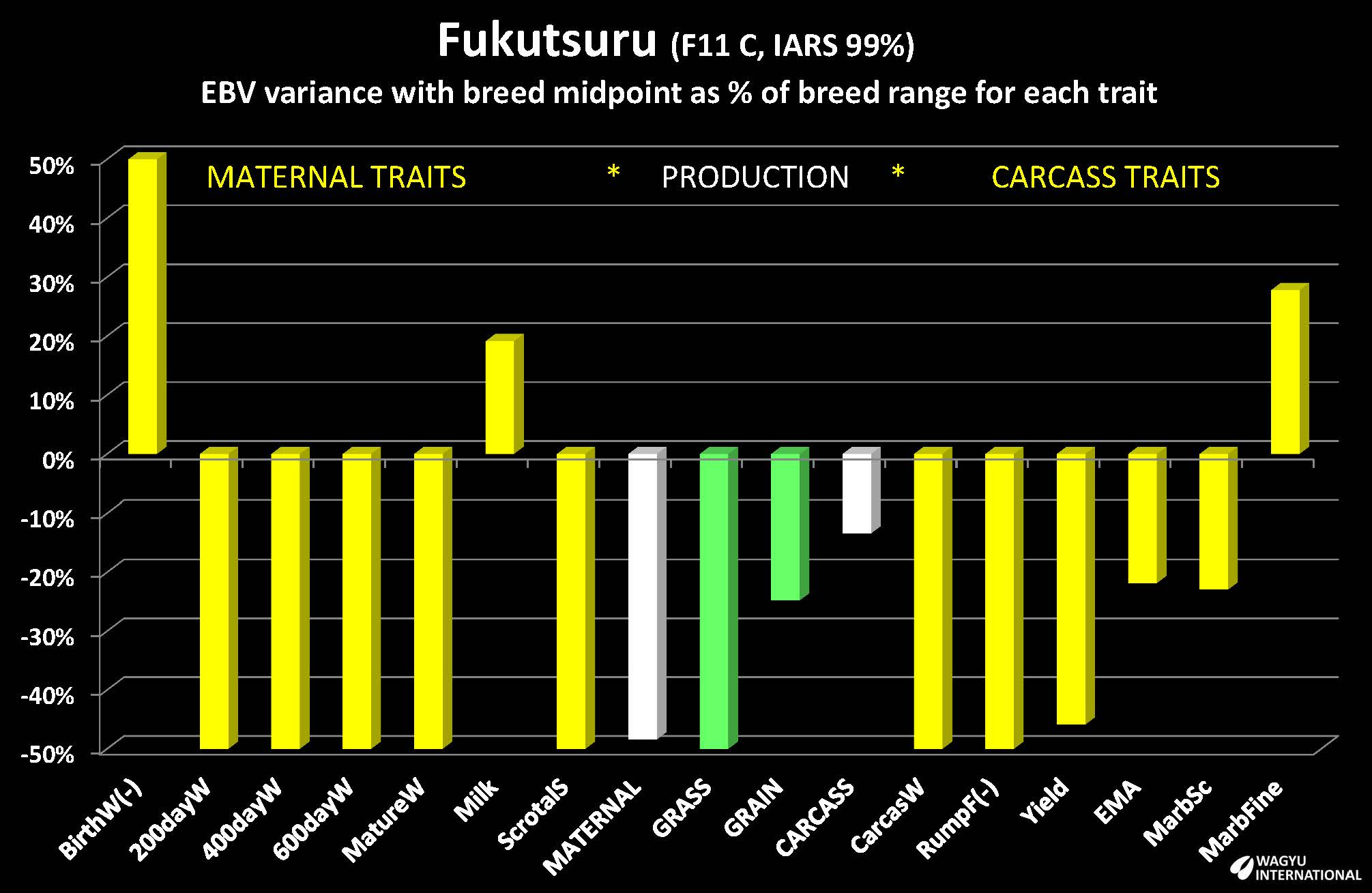
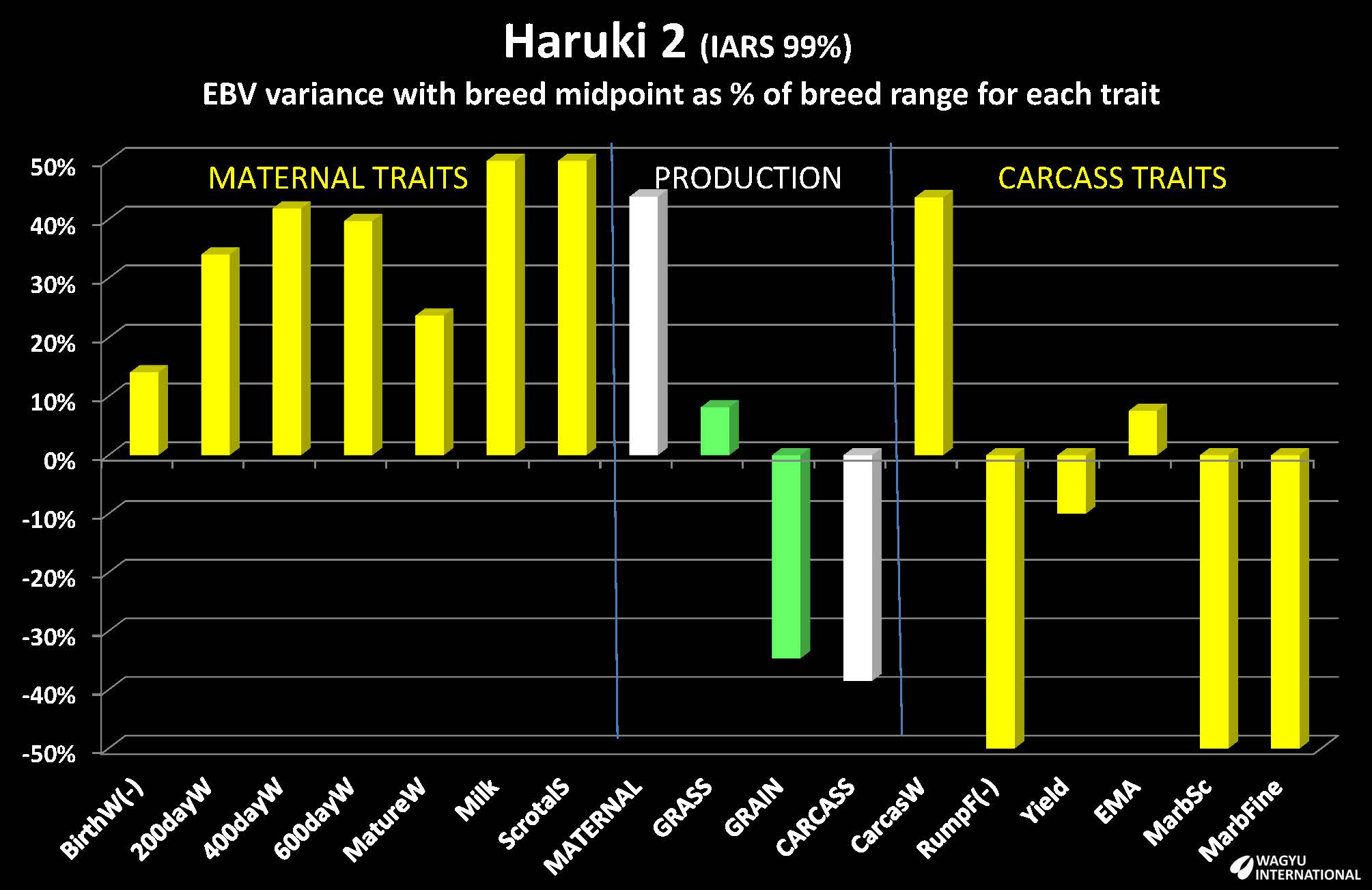
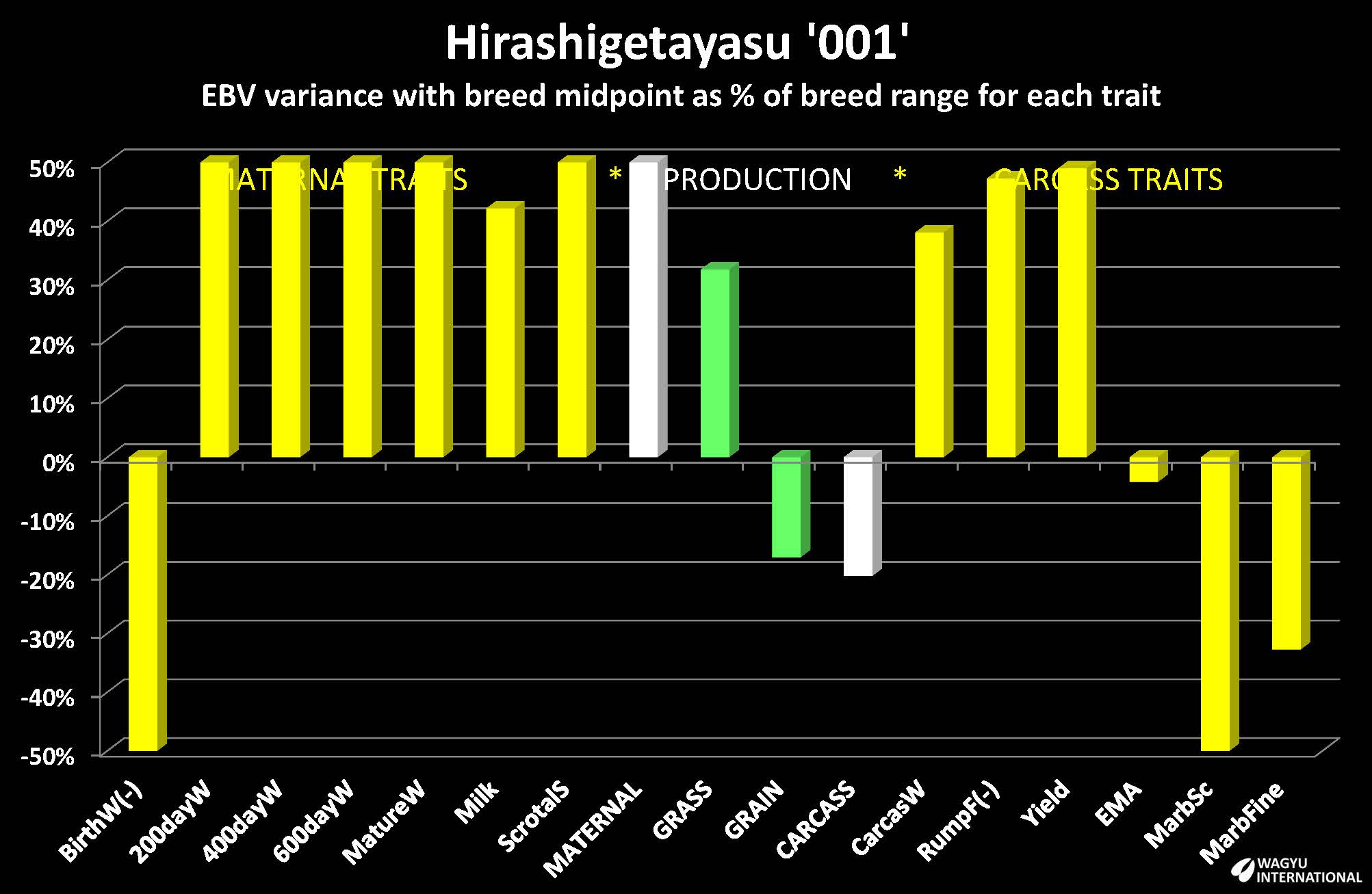
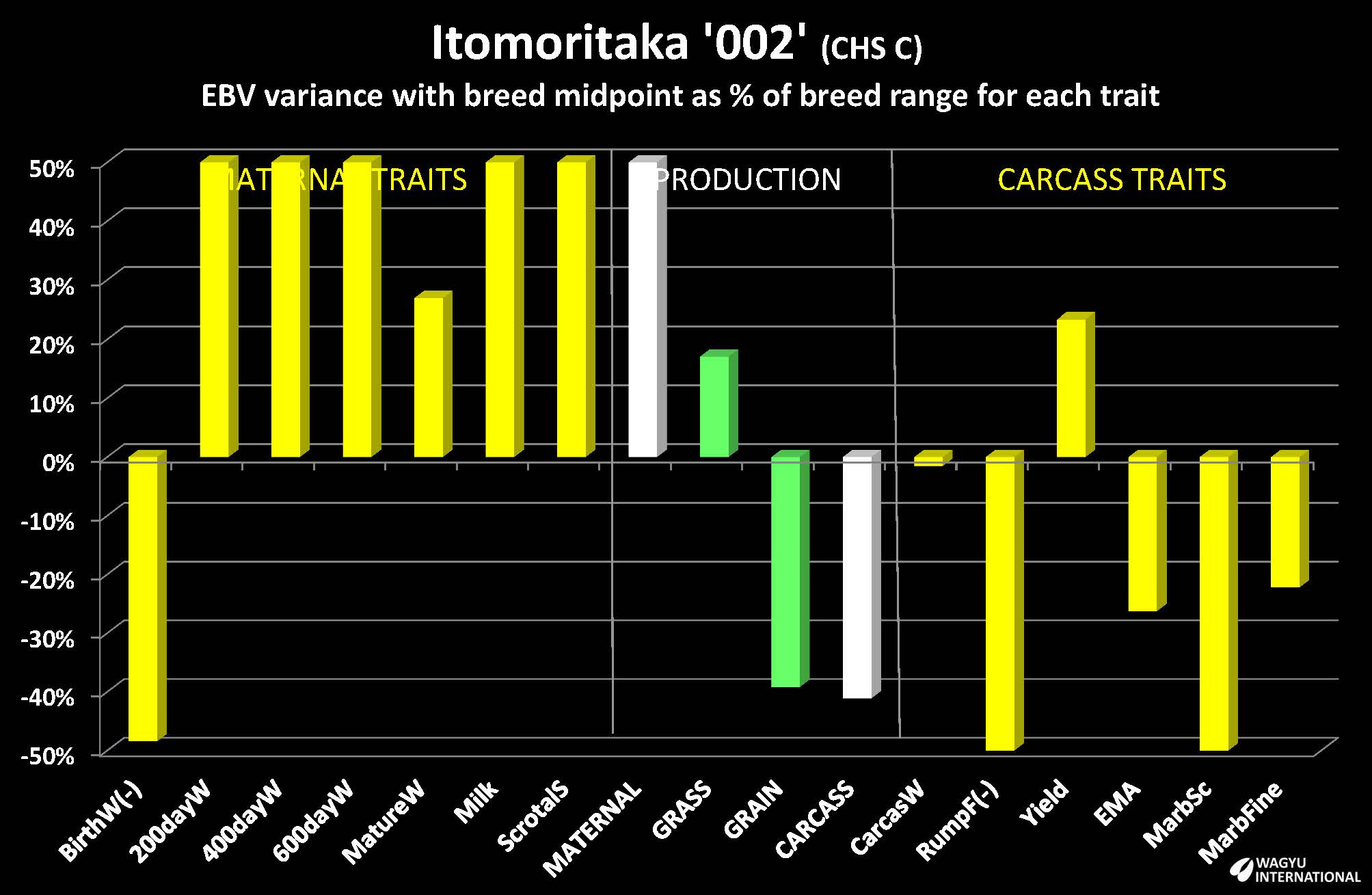
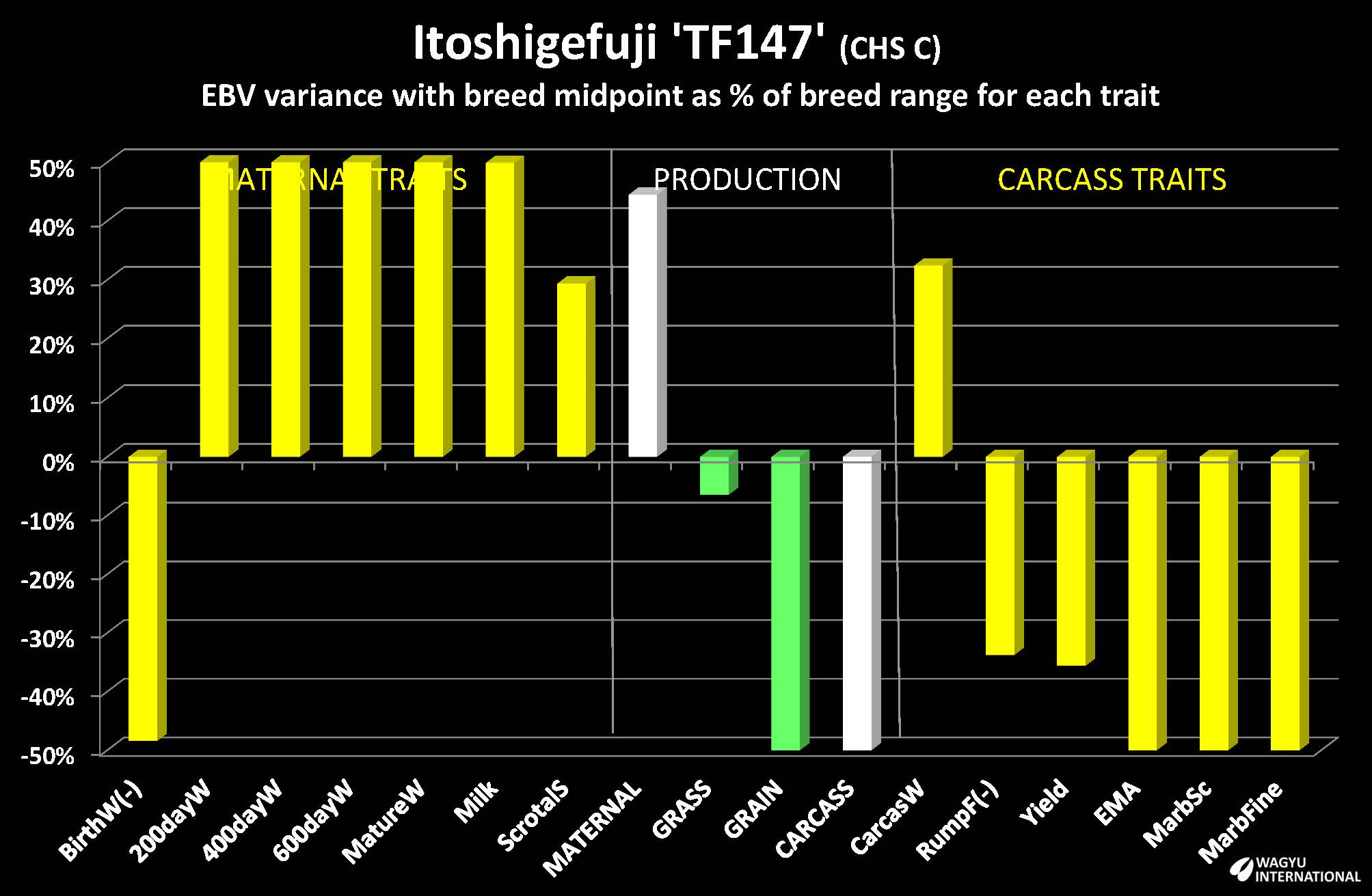
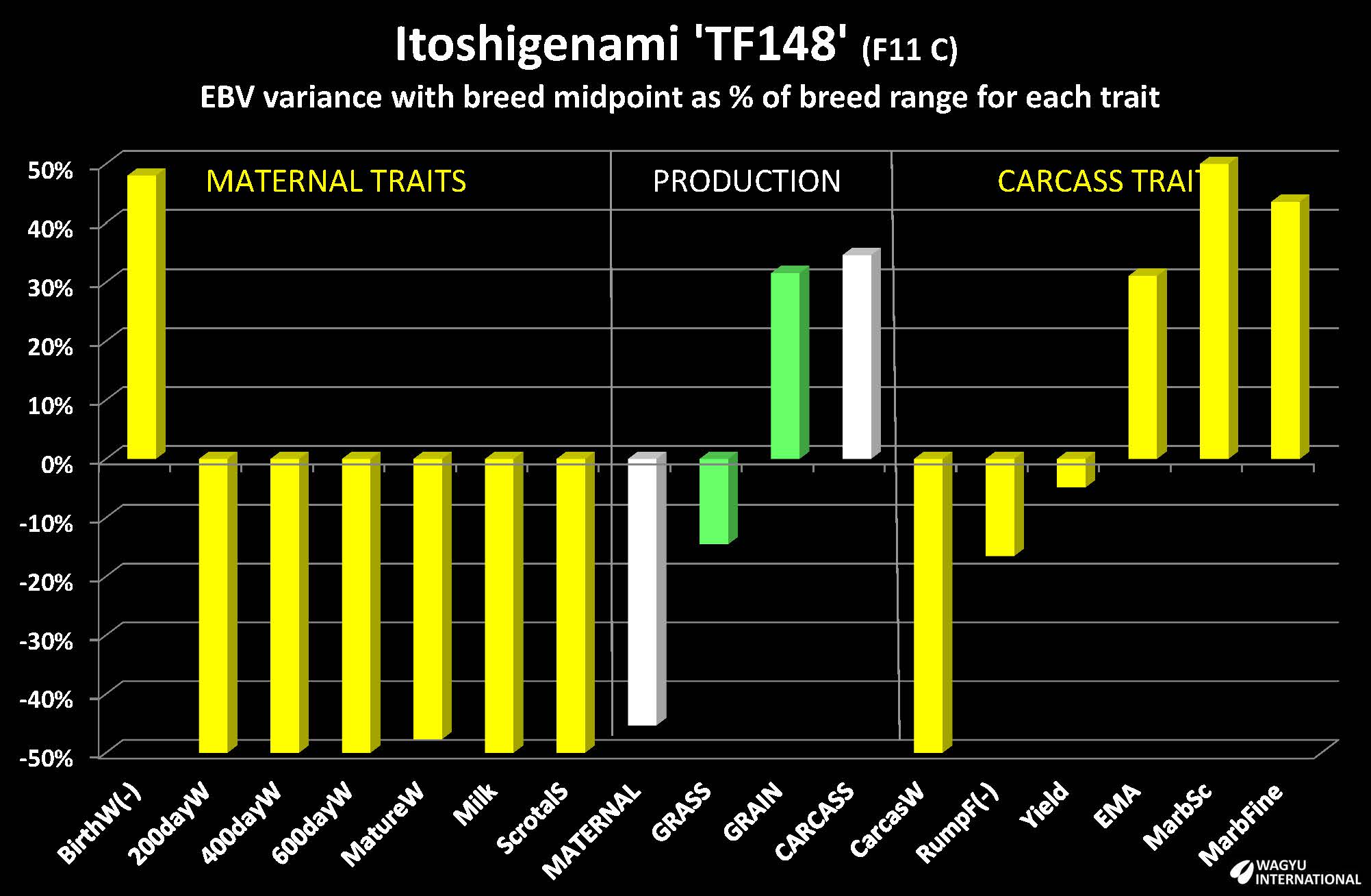
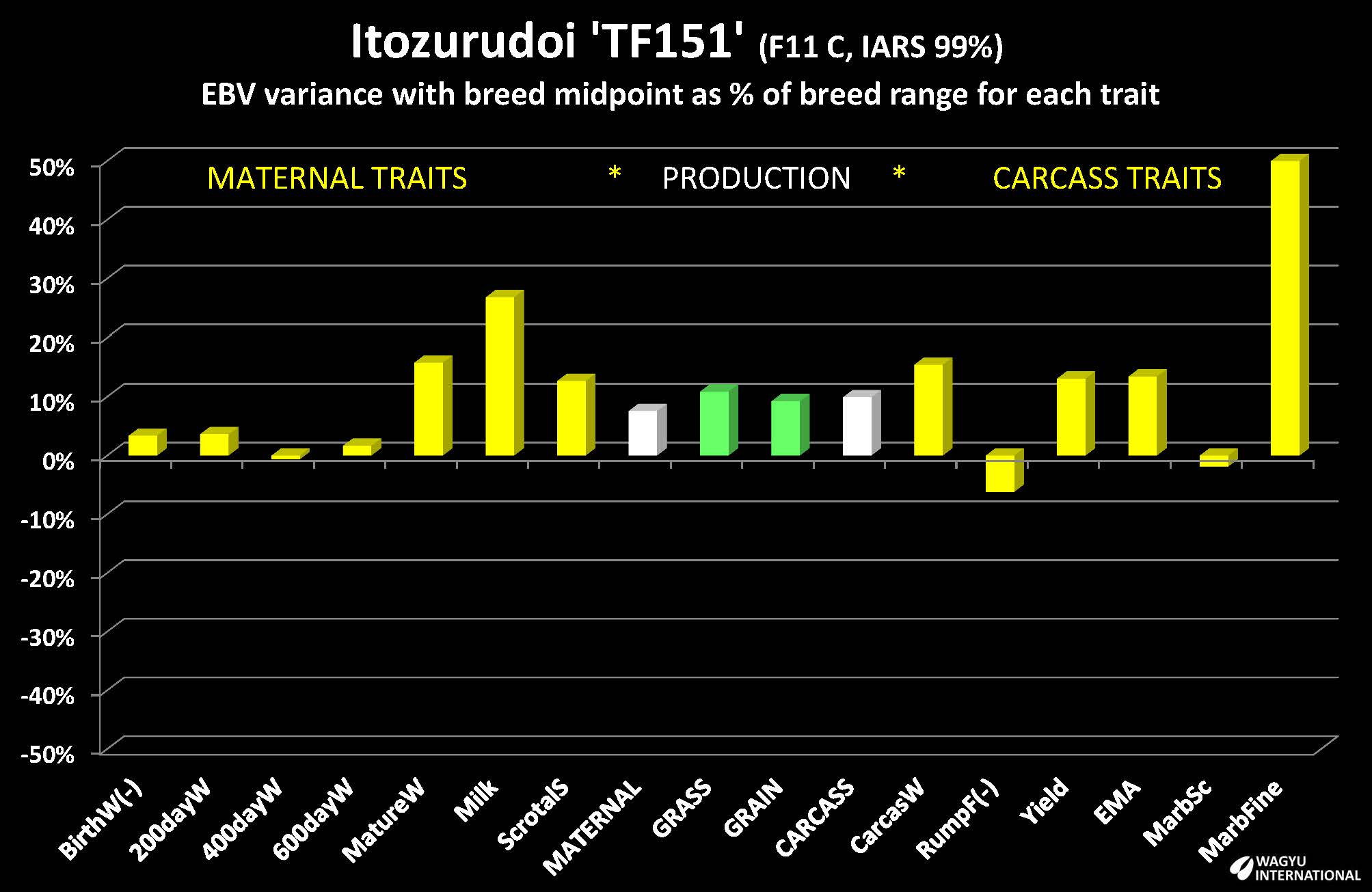
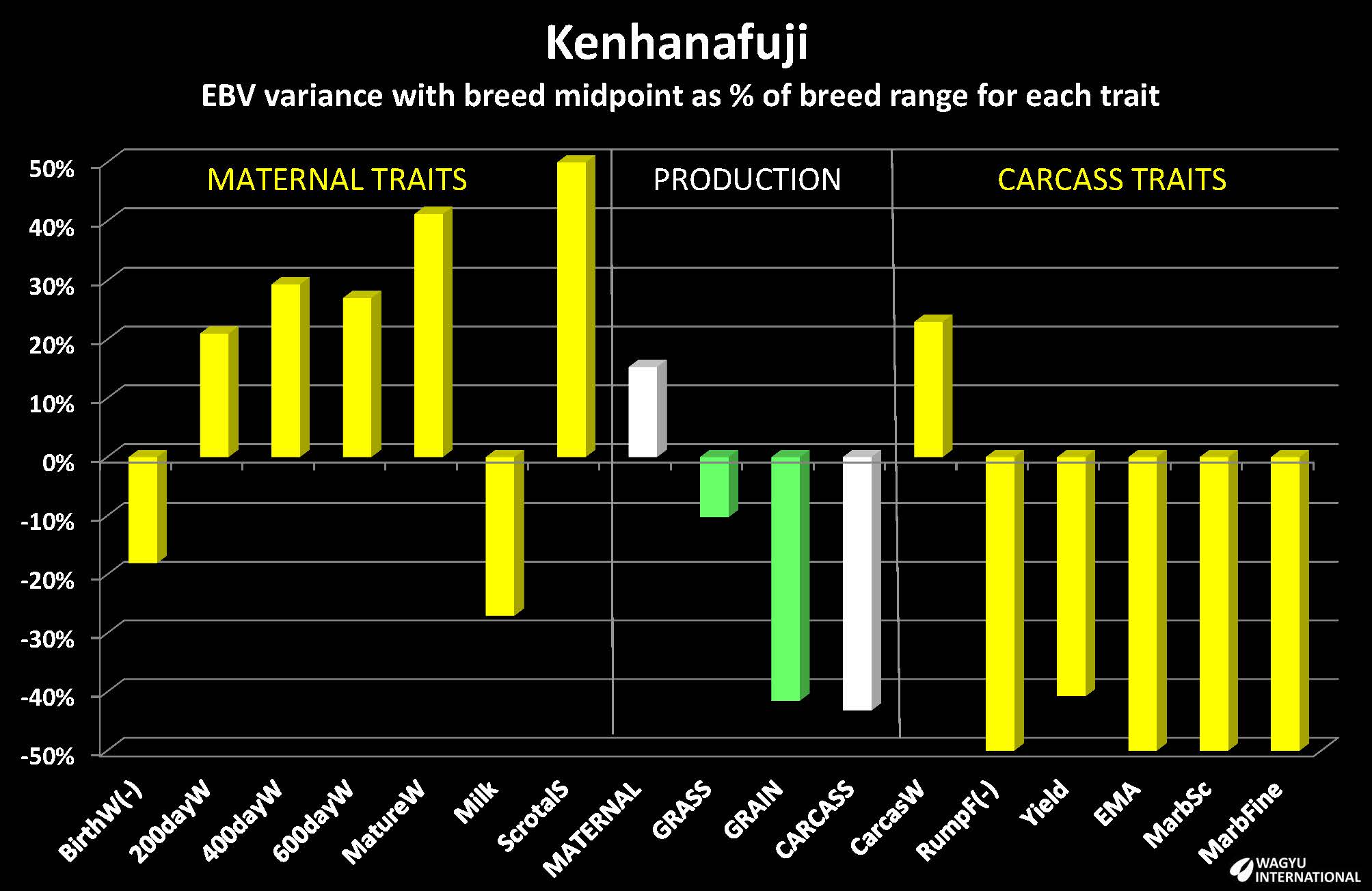
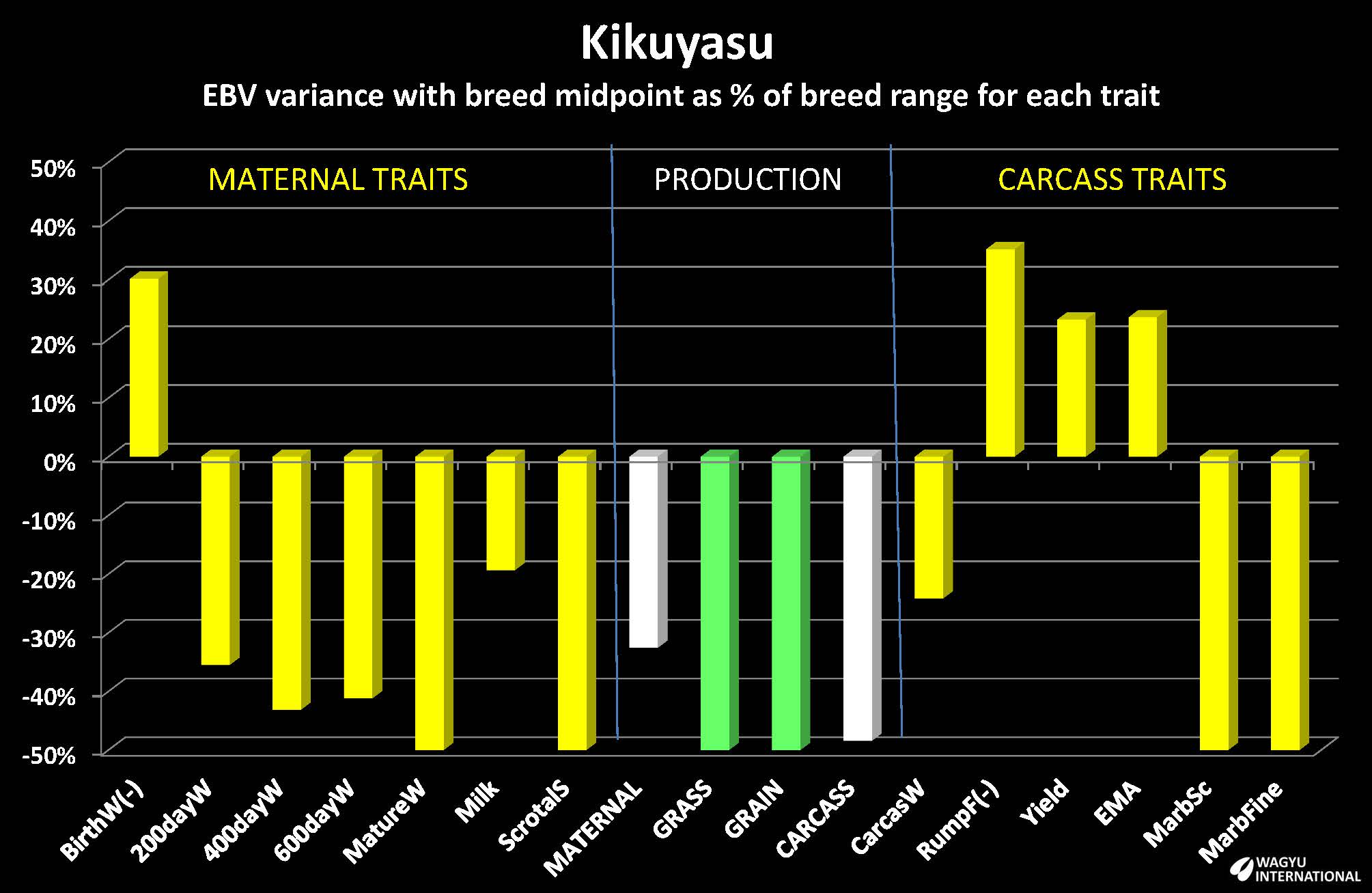
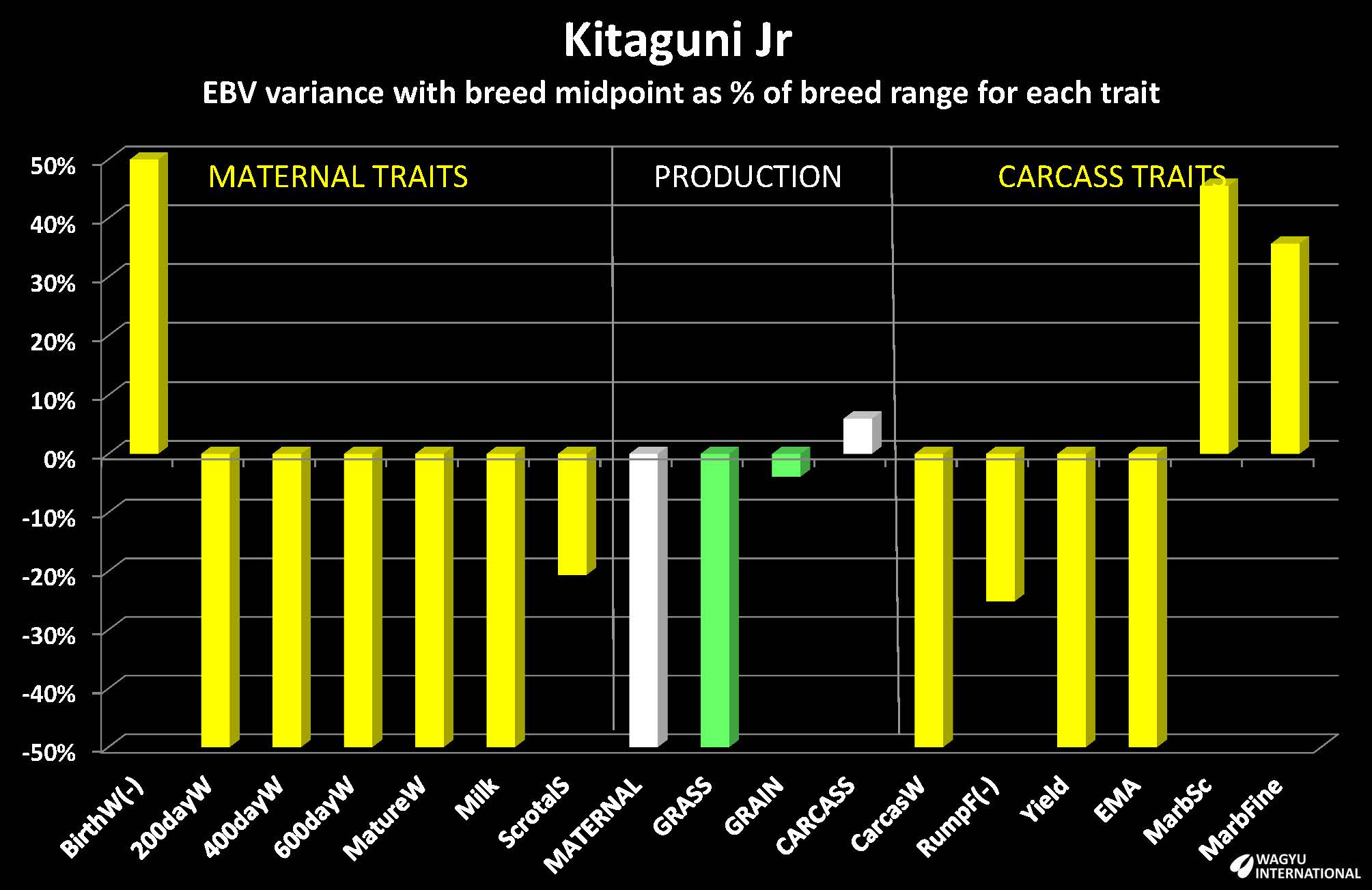
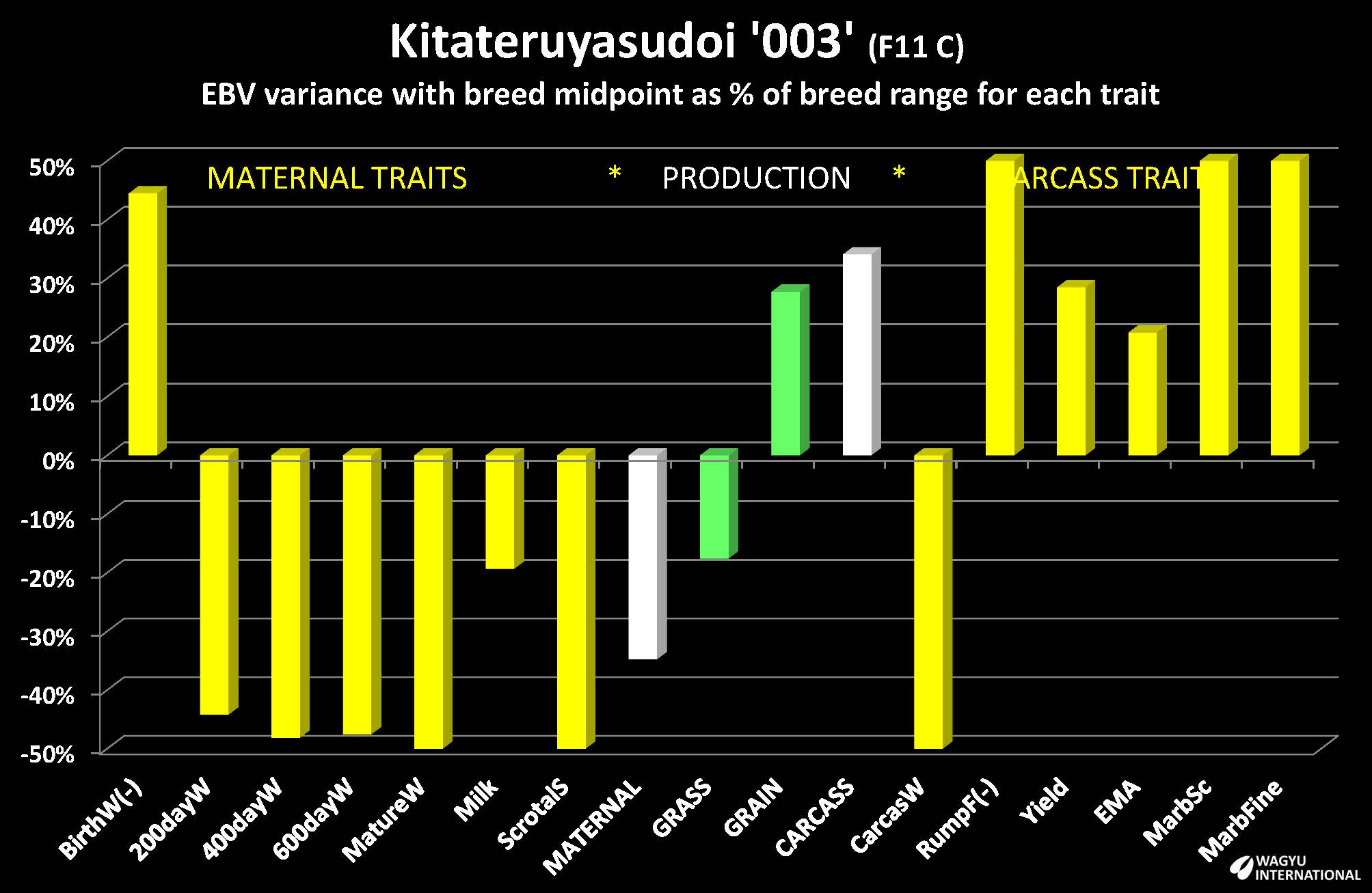
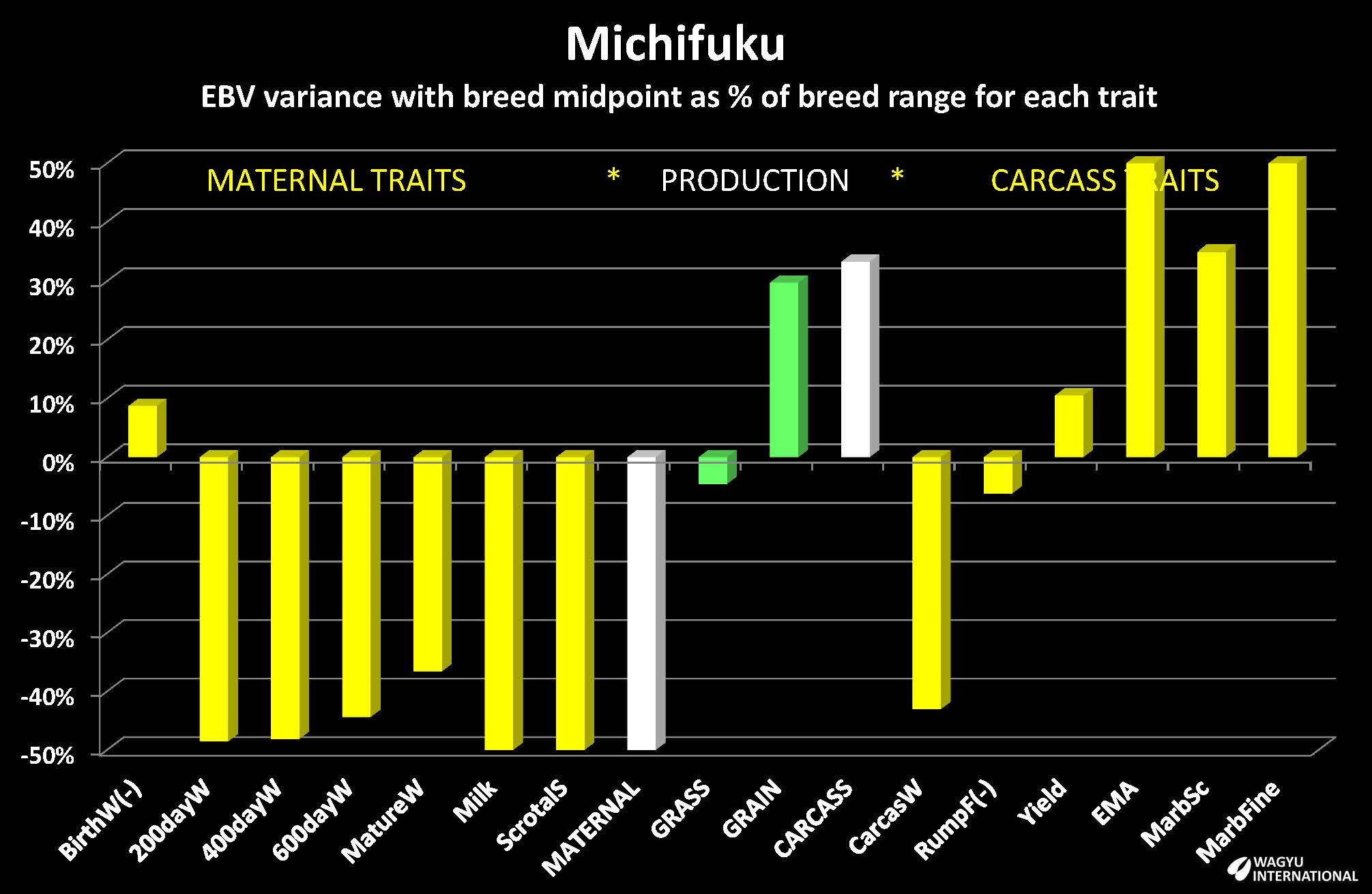
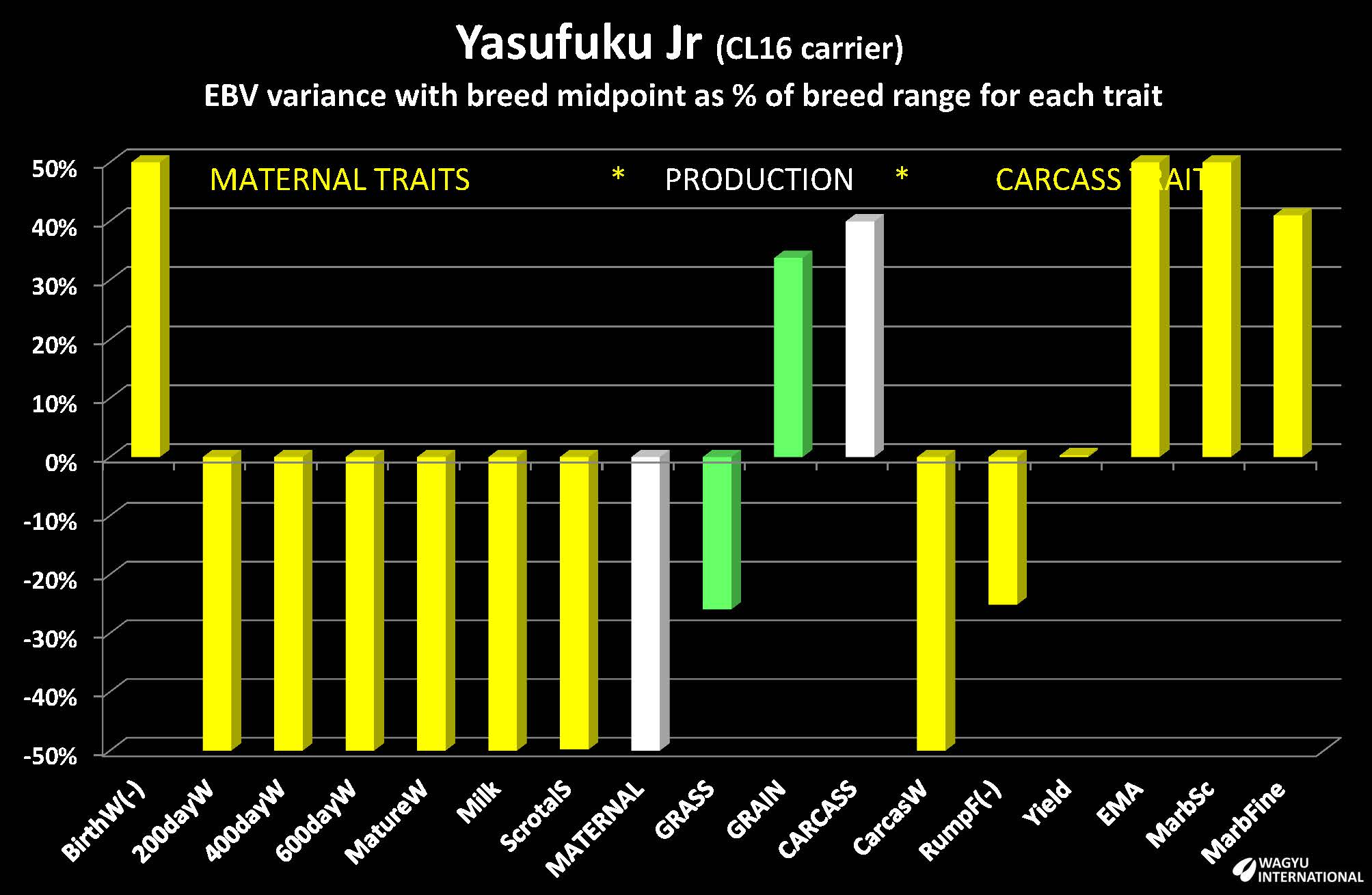
The original Wagyu Foundation sires predominantly either have stronger maternal or carcass traits. Itozurudoi 'TF151' is the only that has positive both Grain and Grass finishing scores that are postive - i.e both average indstry average. Hirashigetayasu, Itomoritaka '002' and Haruki 2 are the three that have a postive Grass score.Yasufuku Jr, Itoshigenami 'TF148', Michifuku and Kitateruyasudoi '003' are the four that have positive Grain scores. The others are negative for both.
The Wagyu International Grain and Grass finishing scores for the Foundations sires are shown below. Grain score is red and Grass score is yellow:
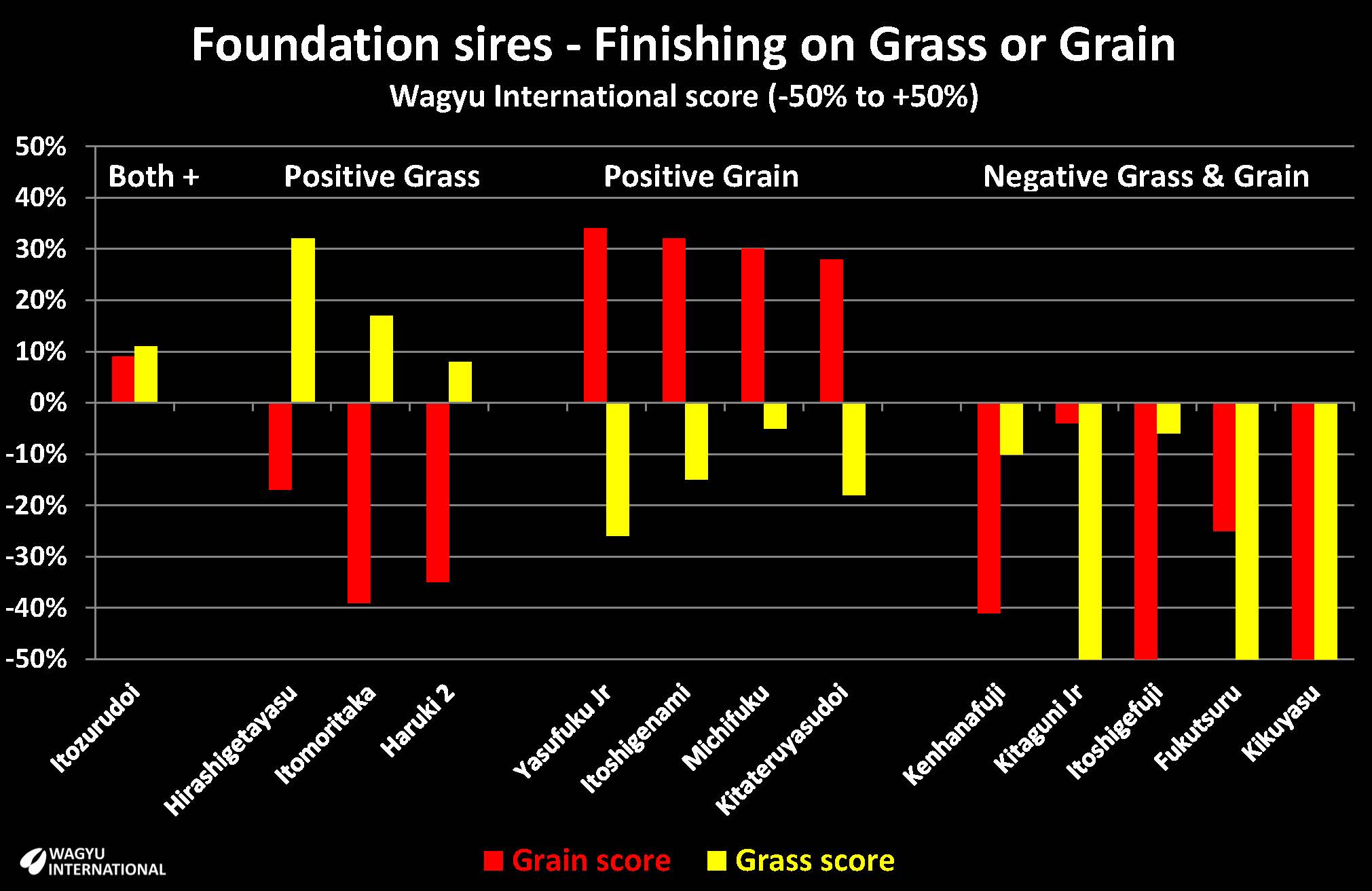
The breeding merit in every generation should be improving from advances with genetic technology. Eight of the most popular Foundations sires have a Production score that exceeds industry average - with a score of 0% or higher. They are positioned within the middle two quartiles in the chart above so there are just as many individuals that have been bred outside Japan that have higher breeding merit as there that have lower breeding merit.
Most of the carcass data out of the several thousand that had been analysed during the generation of genomic EBVs had been submitted from Mayura Station so it was almost inevitable that one of their sires had the highest carcass EBVs. Over time, Mayura Itoshigenami Jnr with 857 carcass progeny is Trait Leader for Marble Score (IMF%), Marbling Fineness and Eye Muscle Area EBV so remains to be the proven champion for breeding merit in the Australian market.
Early growth rate is within the Top 20% of the industry so he is predictably +50% for his Wagyu International Grain finishing score, but excels almost as well with +46% for his Grass finishing score.
Mayura Itoshigenami Jnr breeding merit dashboard is presented below:
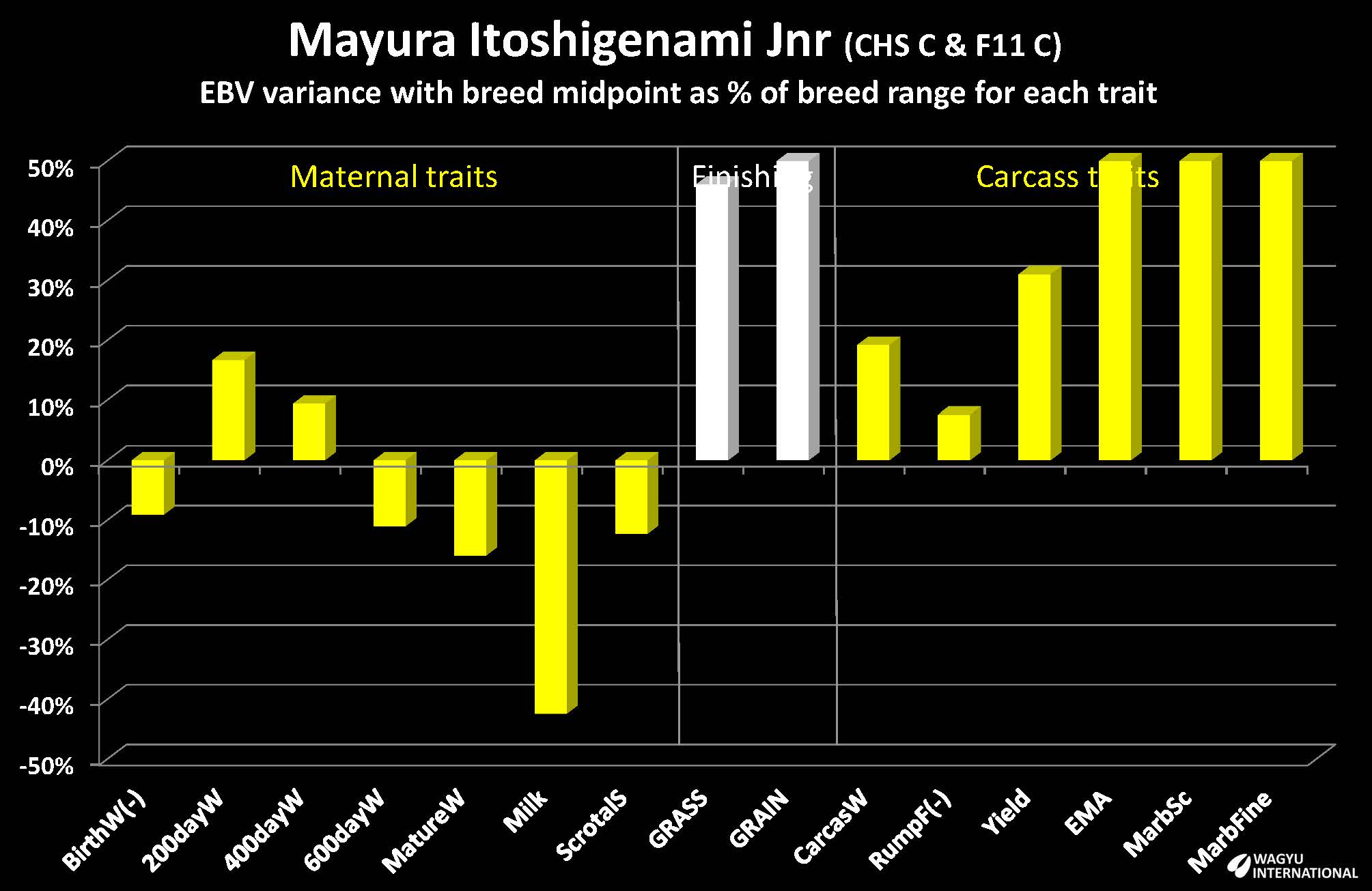
A sire that is also in the Top 1% for the most important carcass traits, but also has strong growth is Coates Itoshigenami G113. The late Simon Coates only got his genomic EBVs after he had sold him but he still got good use from this exceptional sire. The above average breeding merit is illustrated below:
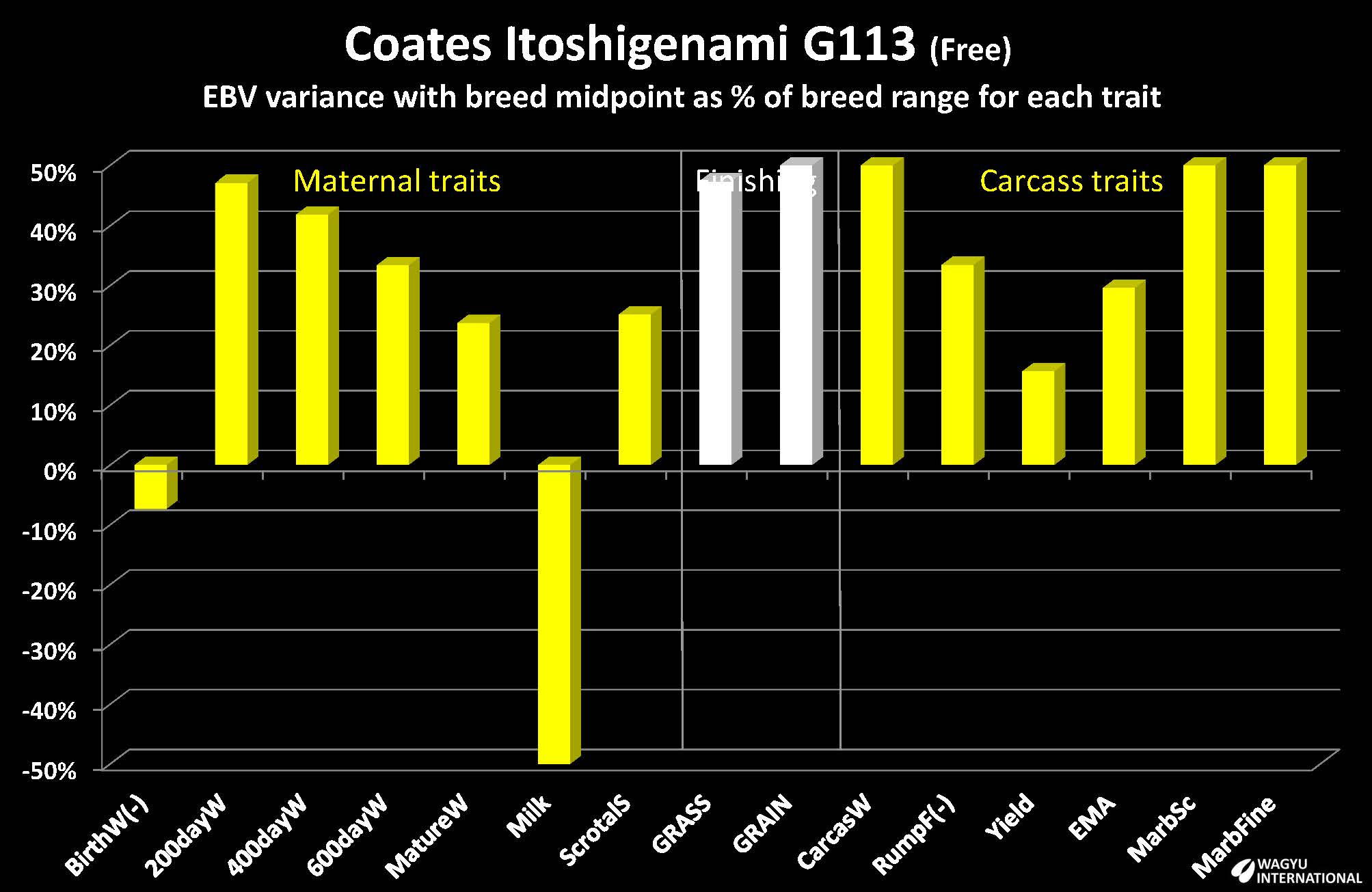
Another top of the range Simon Coates's sire is Sumo Michifuku F154. One of his sons that is favourably priced for exports despite an excellent EBV dashboard and Wagyu International Grain finishing score of +49% and Grass finishing score +42% is Circle8Bulls Q122:
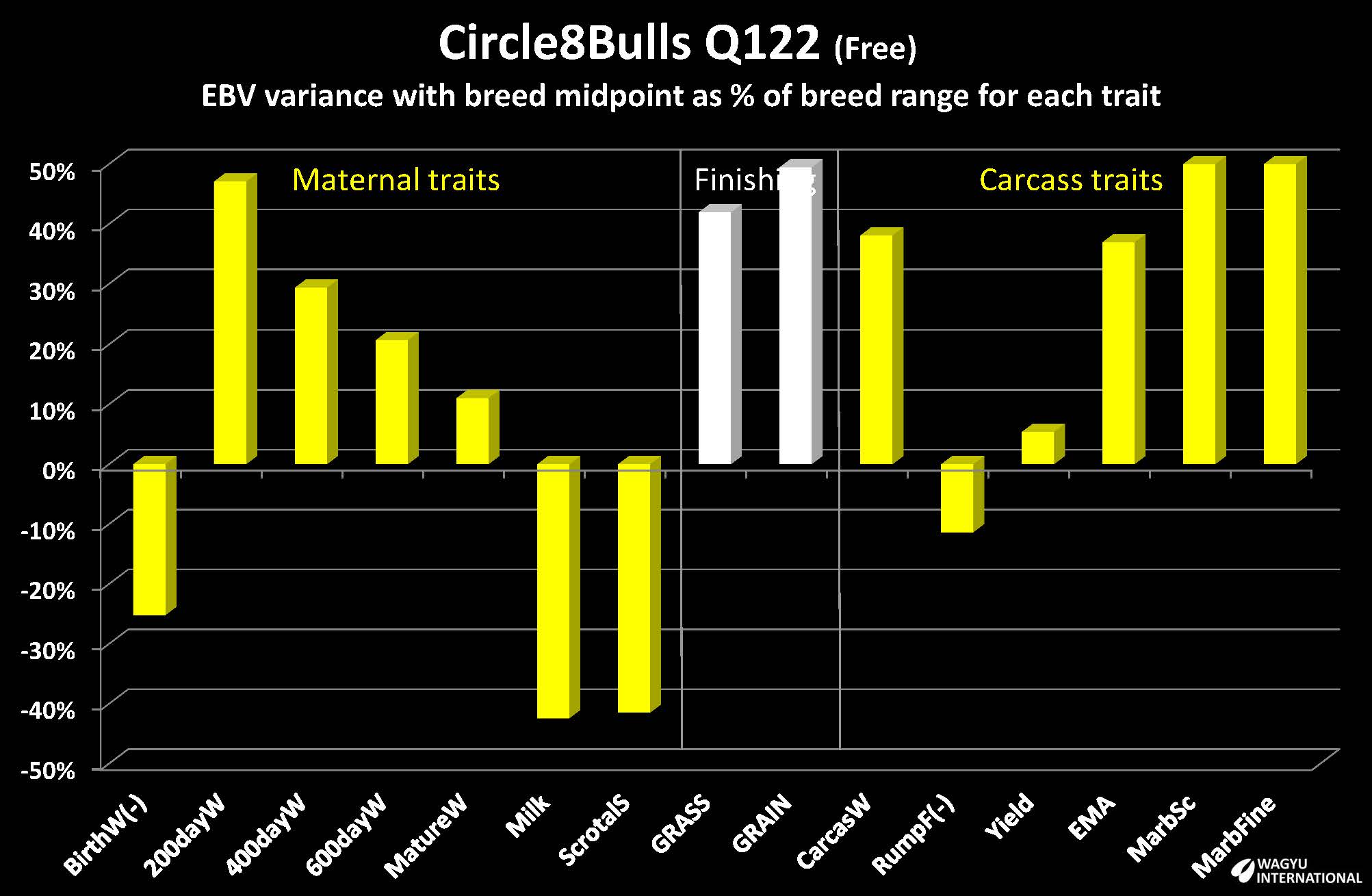
Red Wagyu/Akaushi Foundation
The Red Wagyu/Akaushi foundation animals that have been independently confirmed to have been selected and exported from Japan, or are their direct descendants, are tabled:

The links between Foundation Red Wagyu/Akaushi with the Japanese Brown ancestors in Kumamoto prefecture is illustrated:
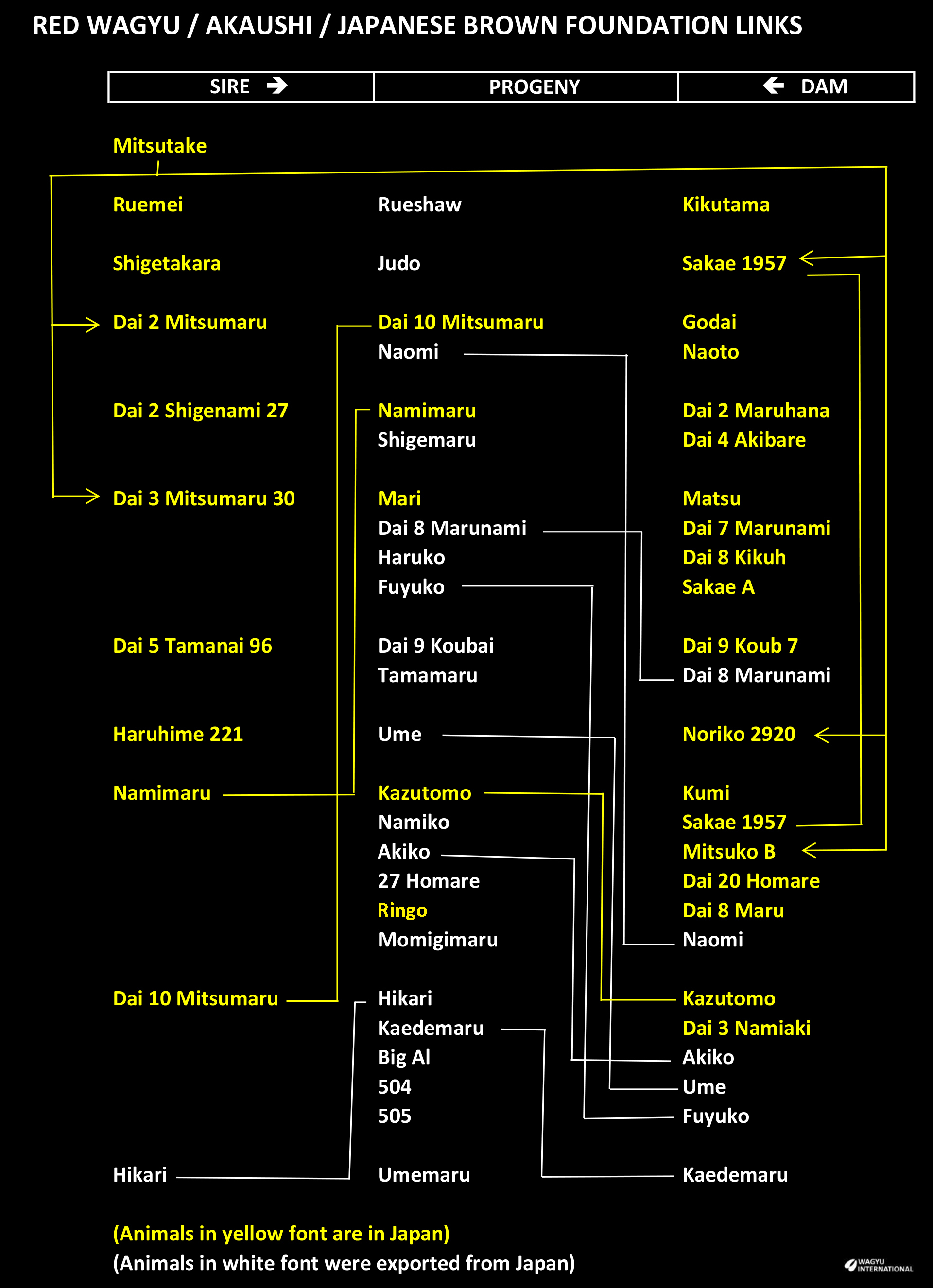
Five Red Wagyu sires were exported from Japan in two shipments, and several of the heifers were pregnant to either Dai 10 Mitsumaru or Namimaru. Even though limited carcase data from 100% Wagyu joinings from registered pedigree is available from the small Akaushi population base, Breedplan EBVs for these sires are illustrated below. 58 Red Wagyu have genomic EBVs out of around 1,000 Red Wagyu with EBVs in Australian Breedplan. In the charts below, EBVs of these Red Wagyu are charted relative to the midpoint and range of the entire Red Wagyu/Akaushi population for which there are EBVs in Australian Breedplan. In other words, reds are ranked with reds. These charts are presented to give a visual indication but the EBVs and their accuracies should be viewed on the Australian Wagyu Association website in order to make breeding decisions.
The two Red Wagyu/Akaushi sires in Japan that had been inseminated to several of the Englewood heifers prior to their export from Japan:
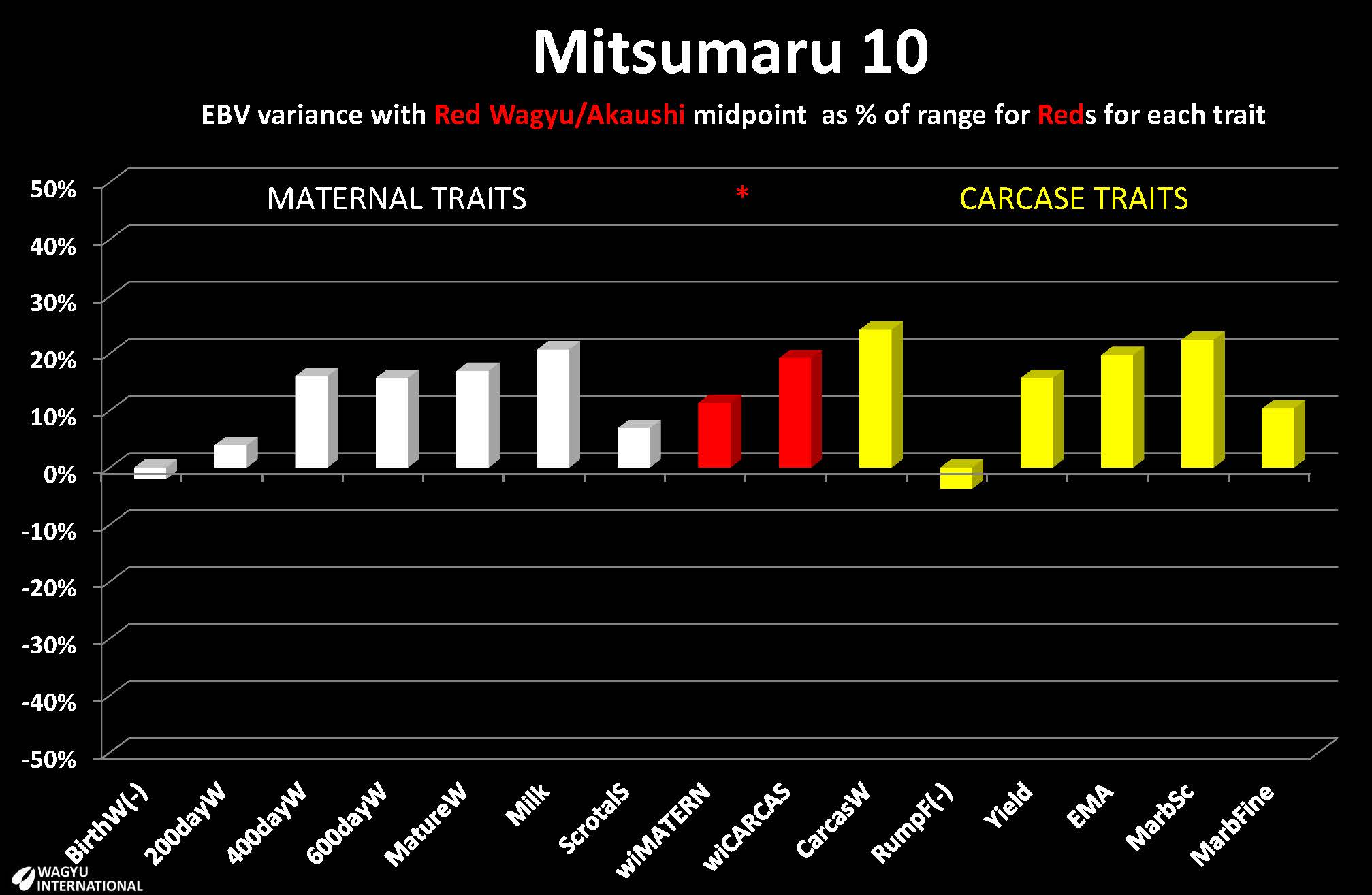
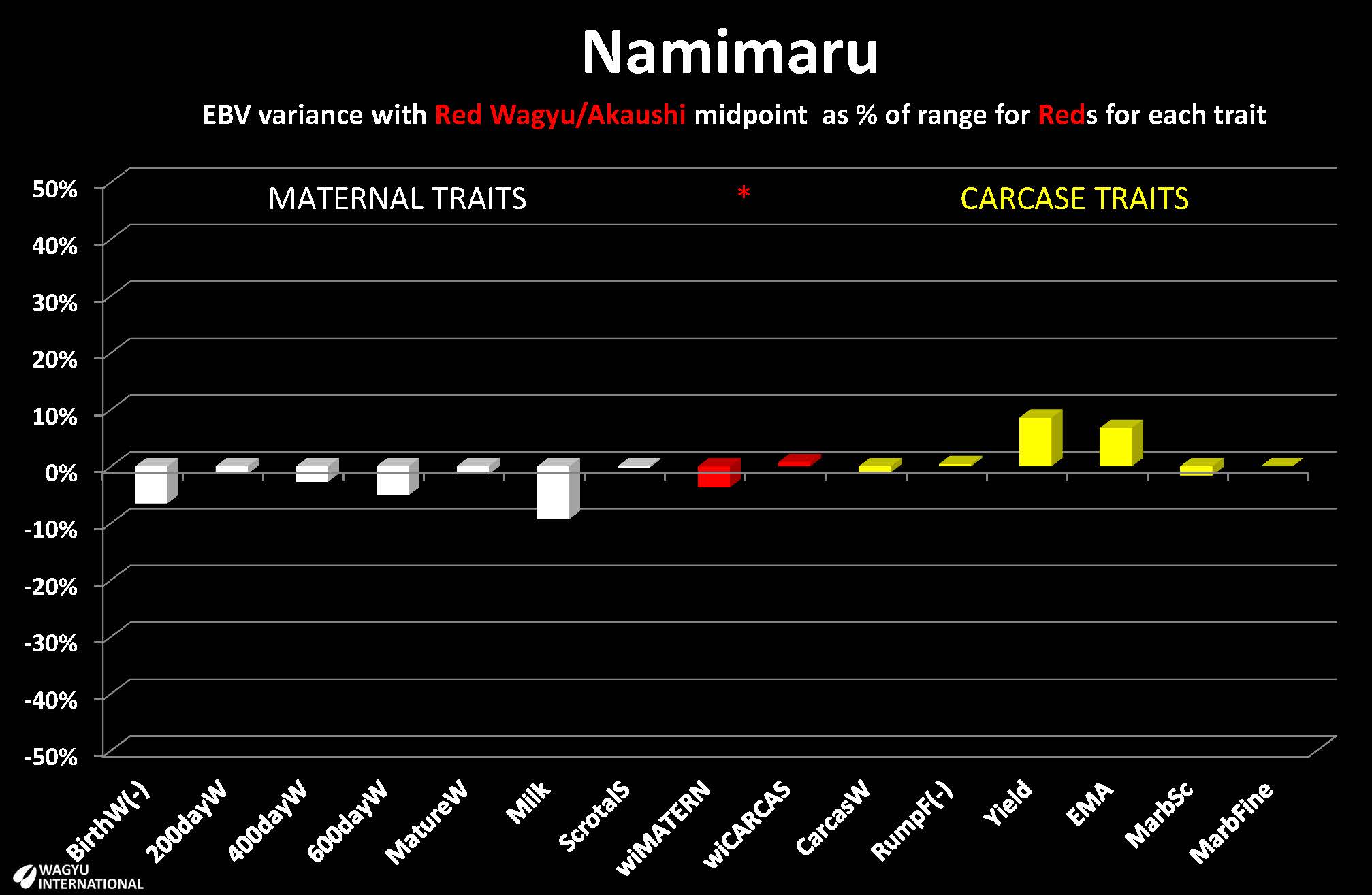
Red Wagyu/Akaushu foundation sires that were exported from Japan in 1976:
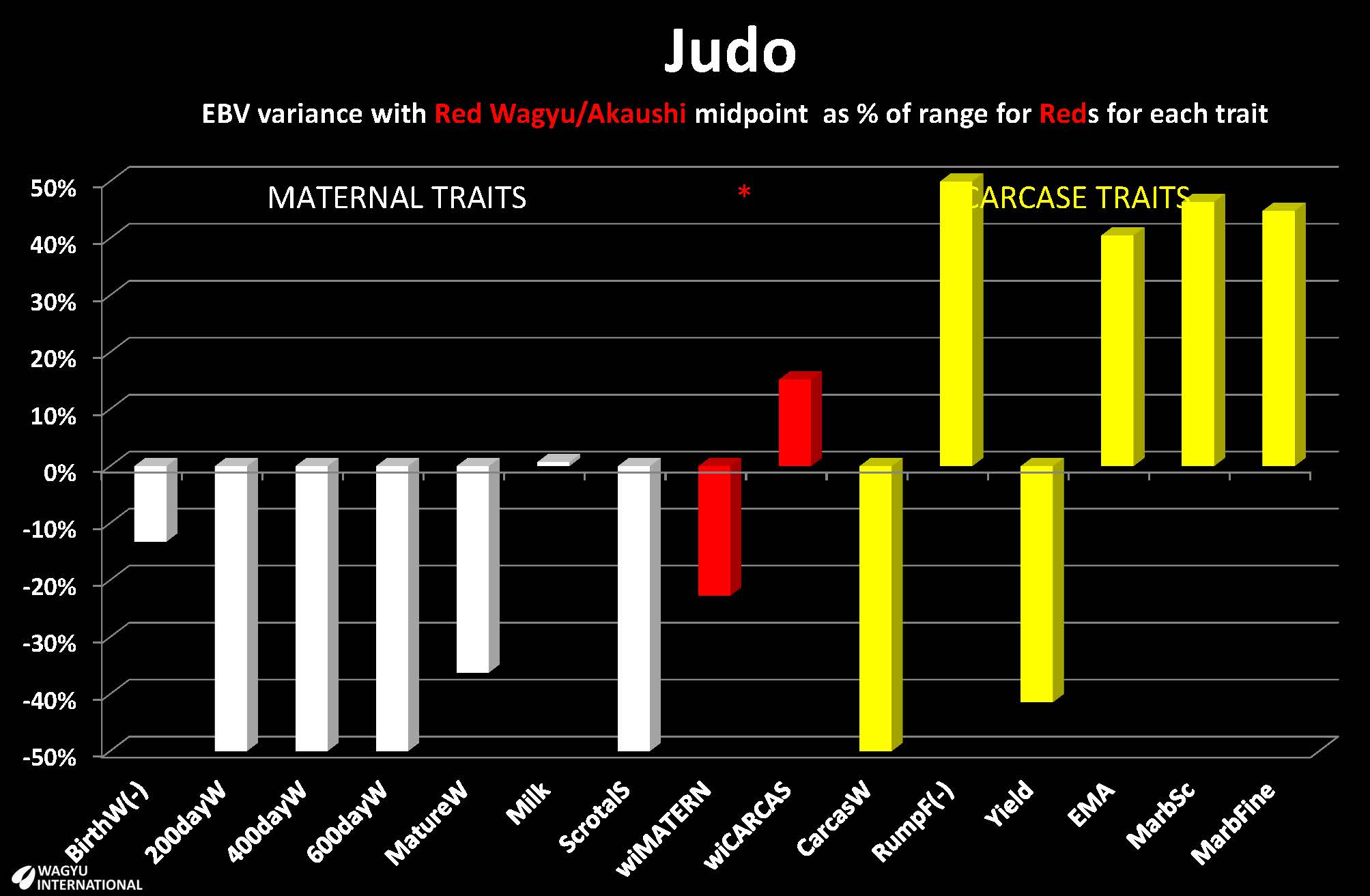
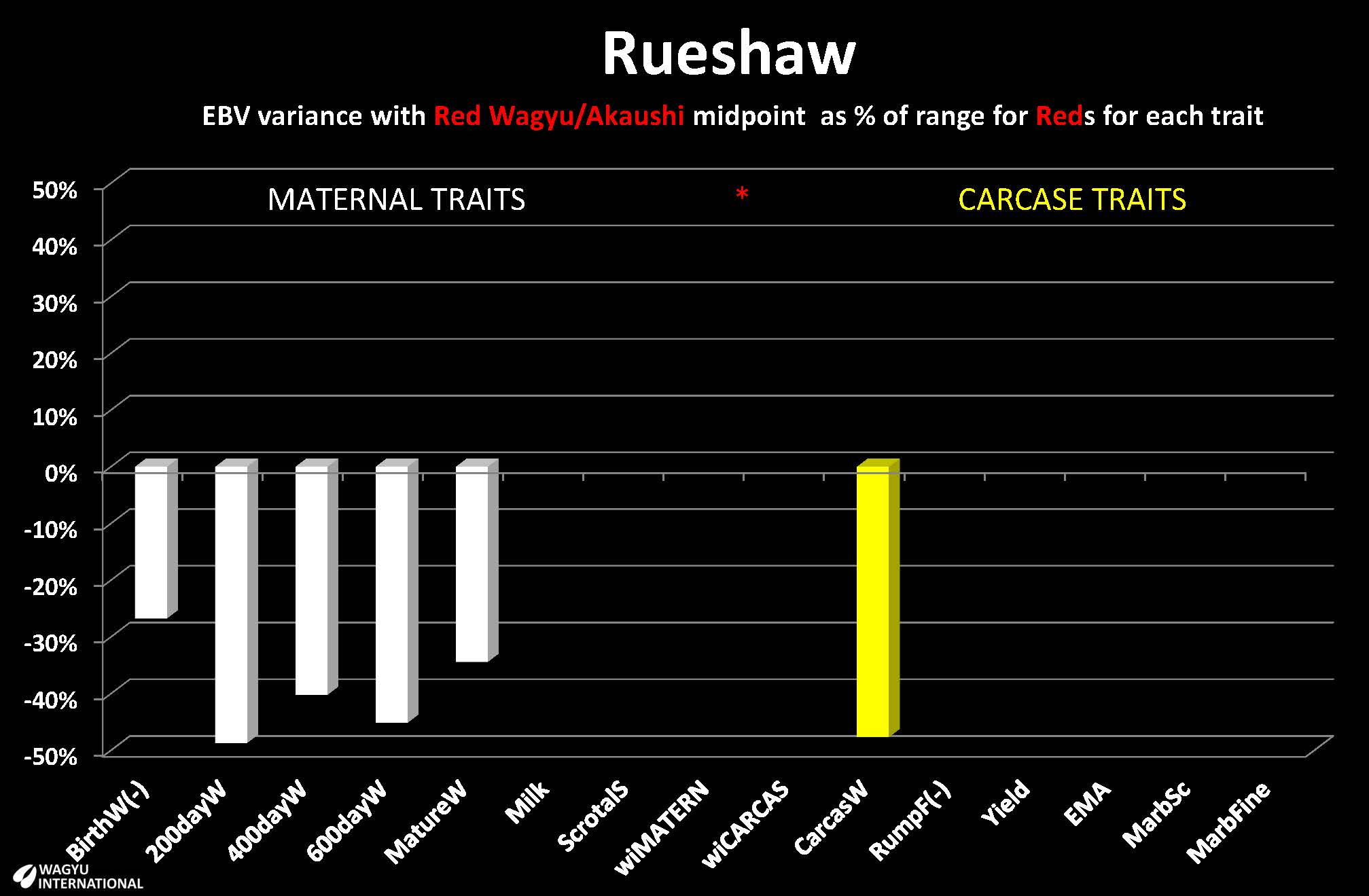
The Red Wagyu/Akaushu foundation sires that were exported from Japan in 1994:
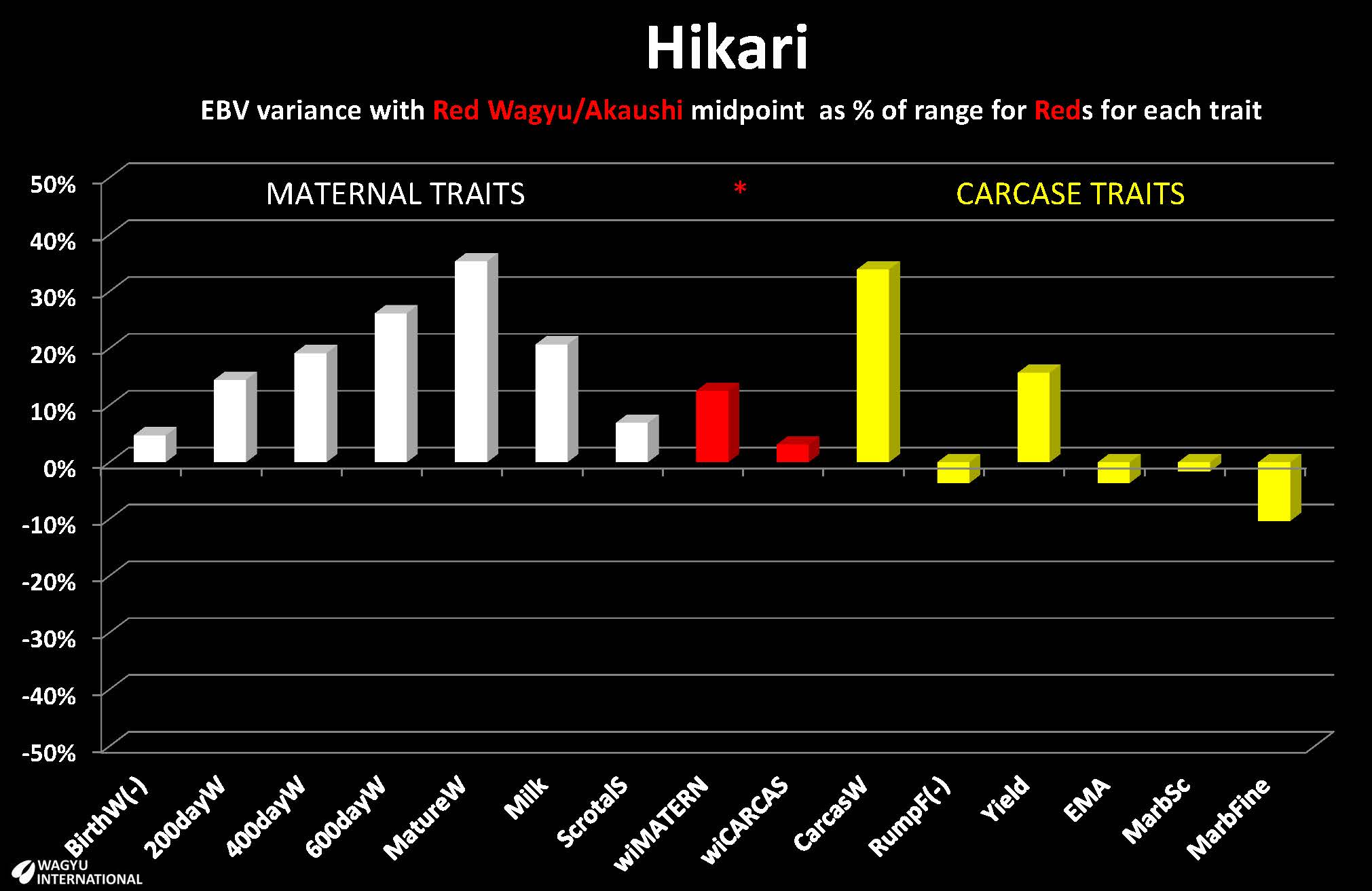
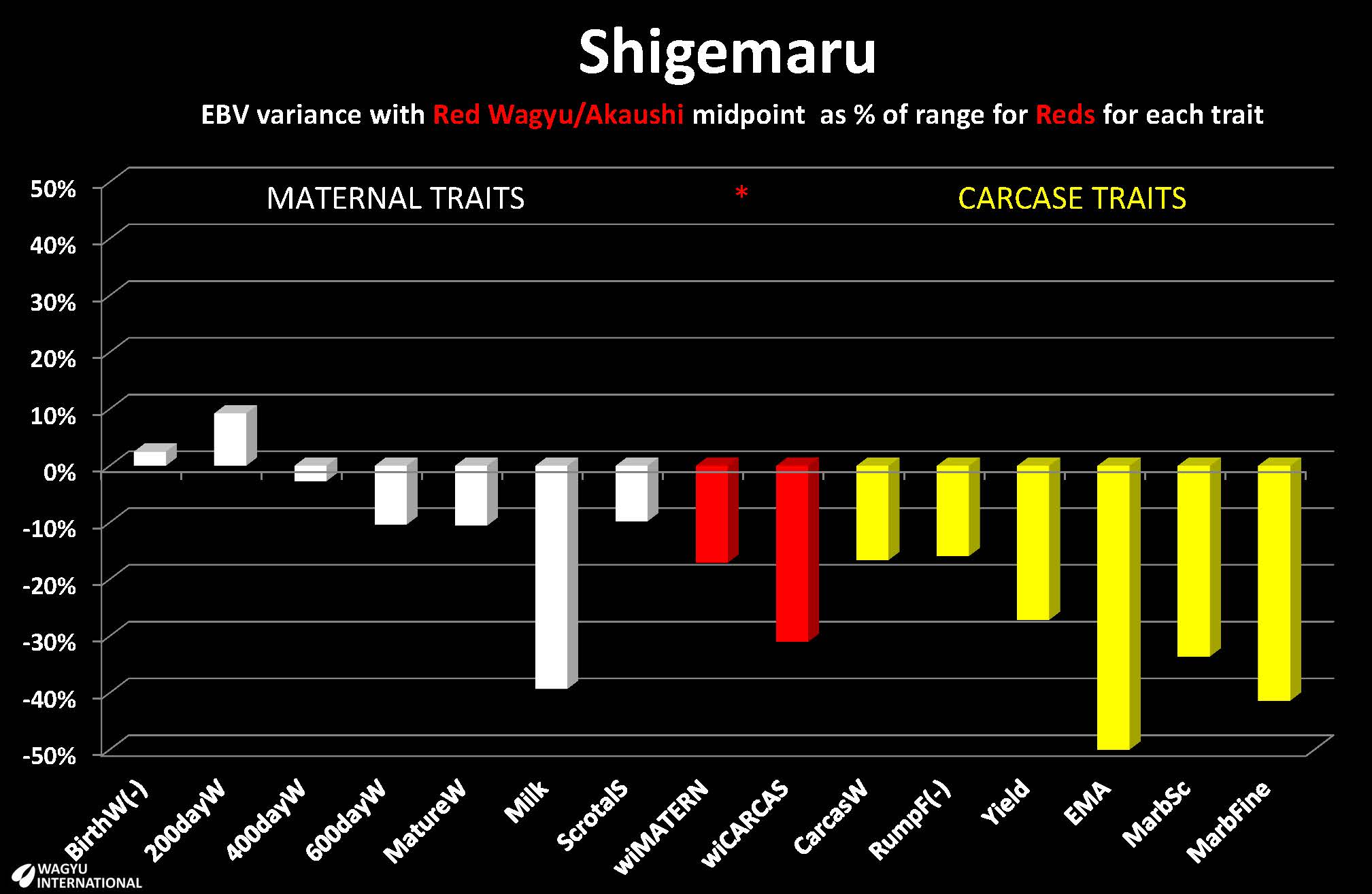
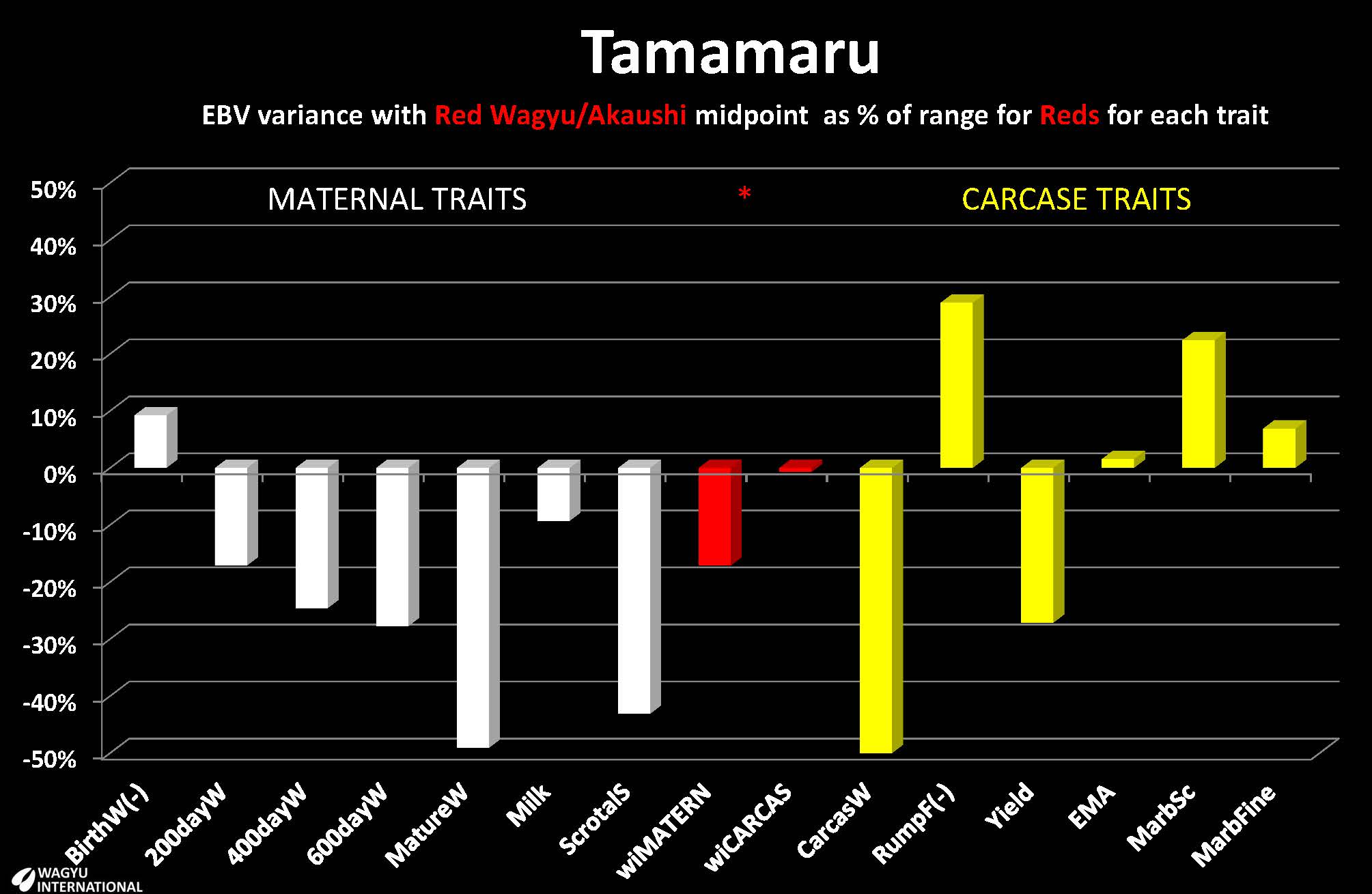
The Red Wagyu/Akaushi heifers that were imported in the 1990s, are shown below.
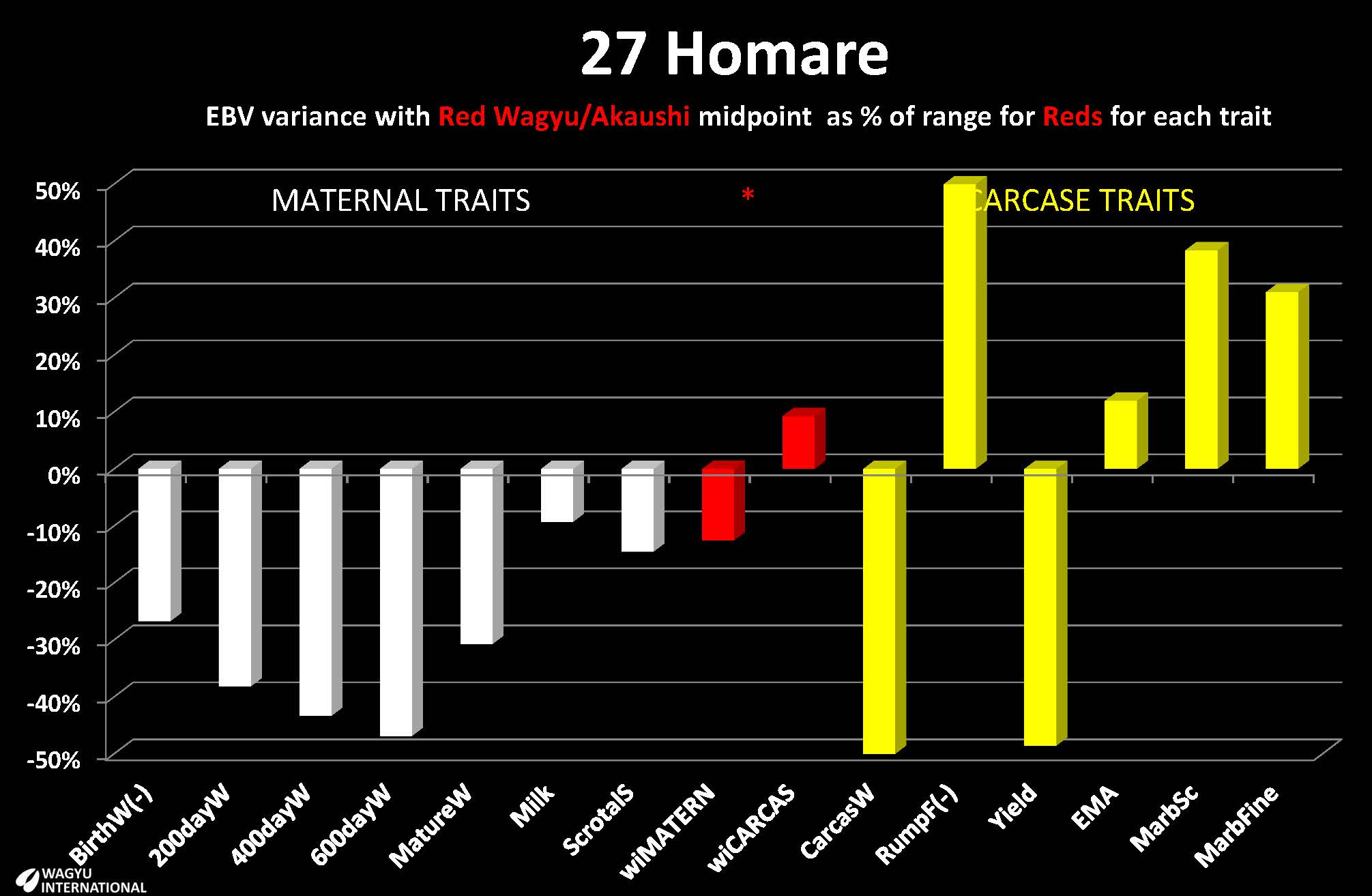
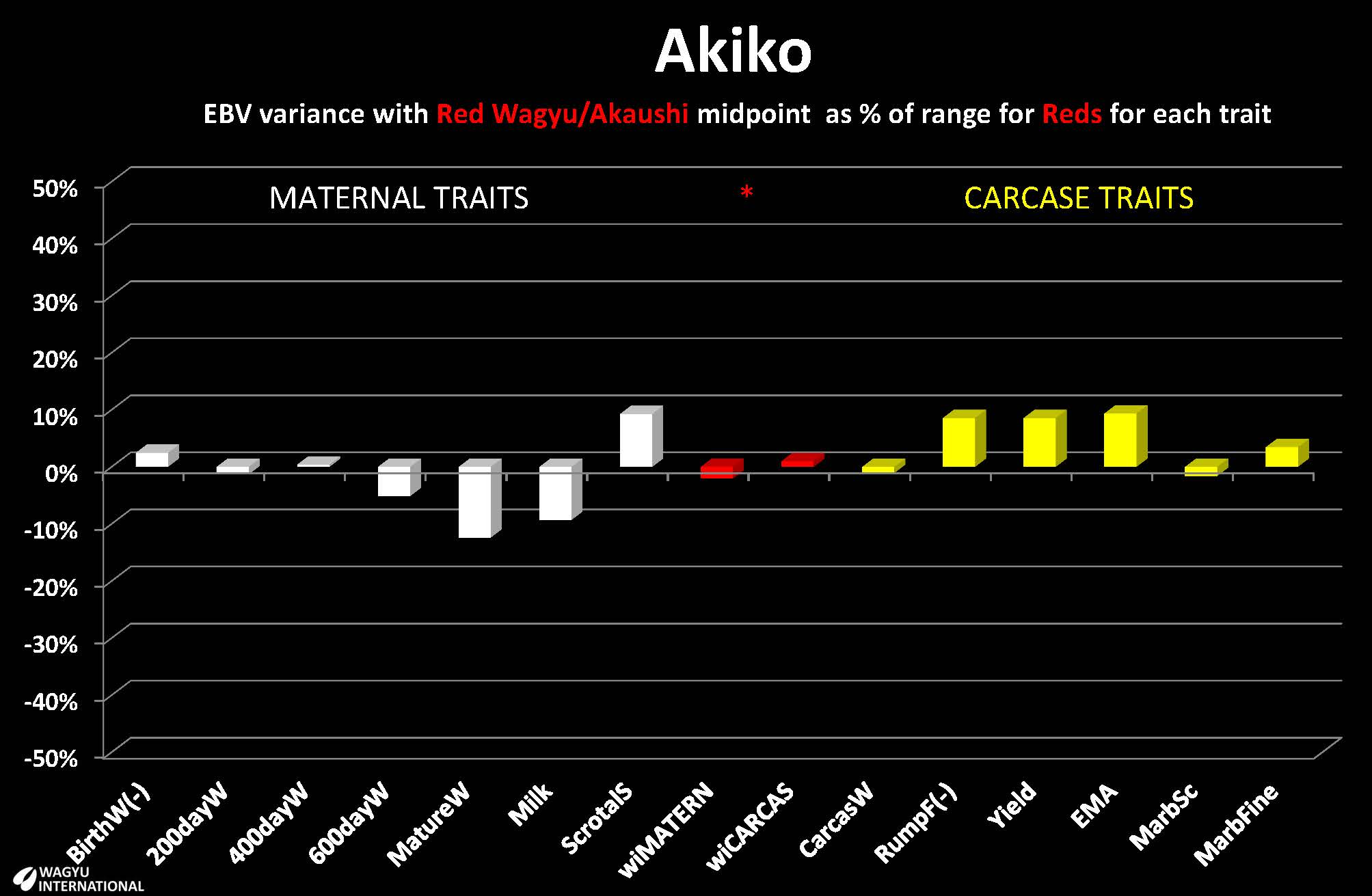
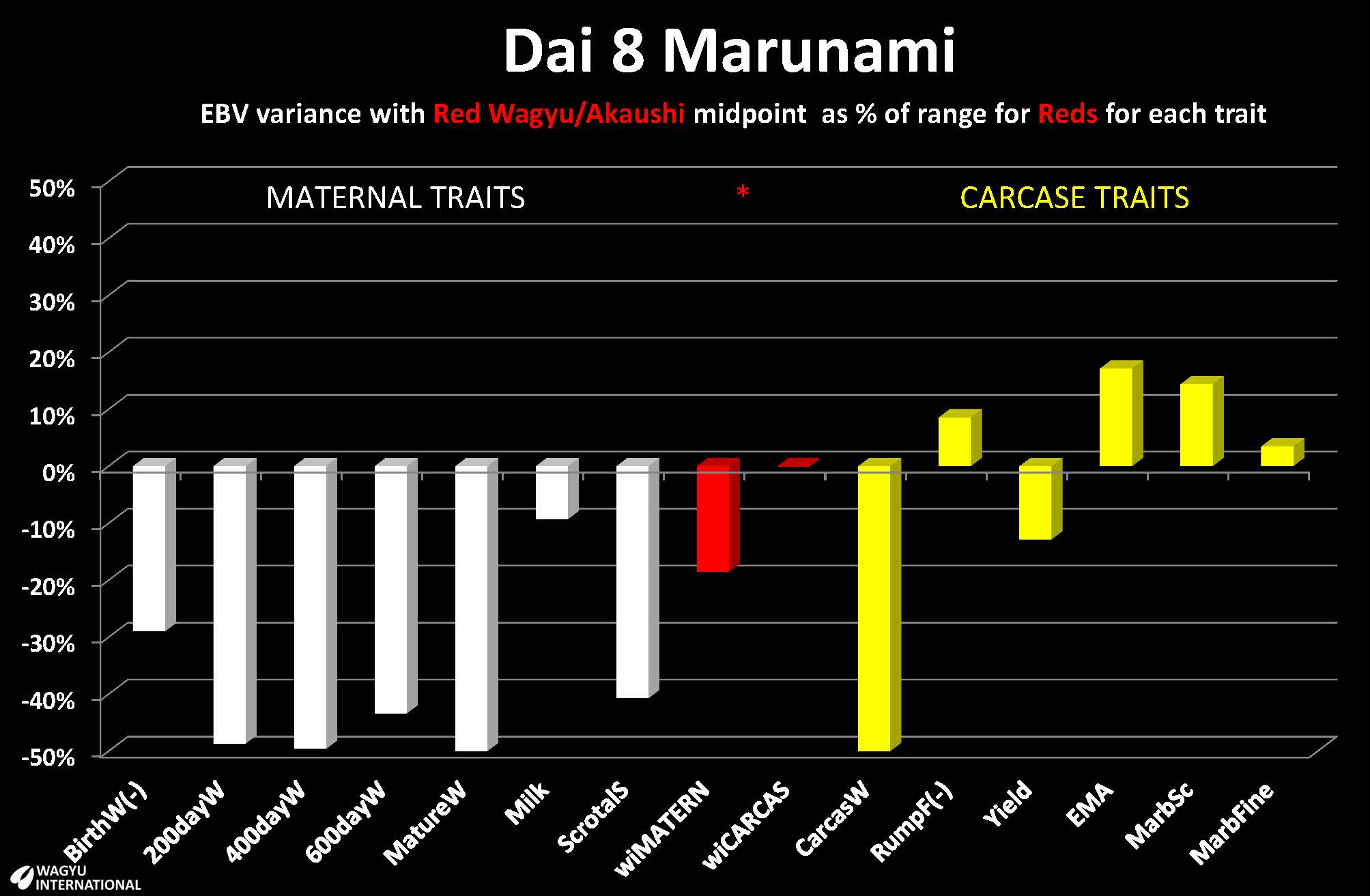
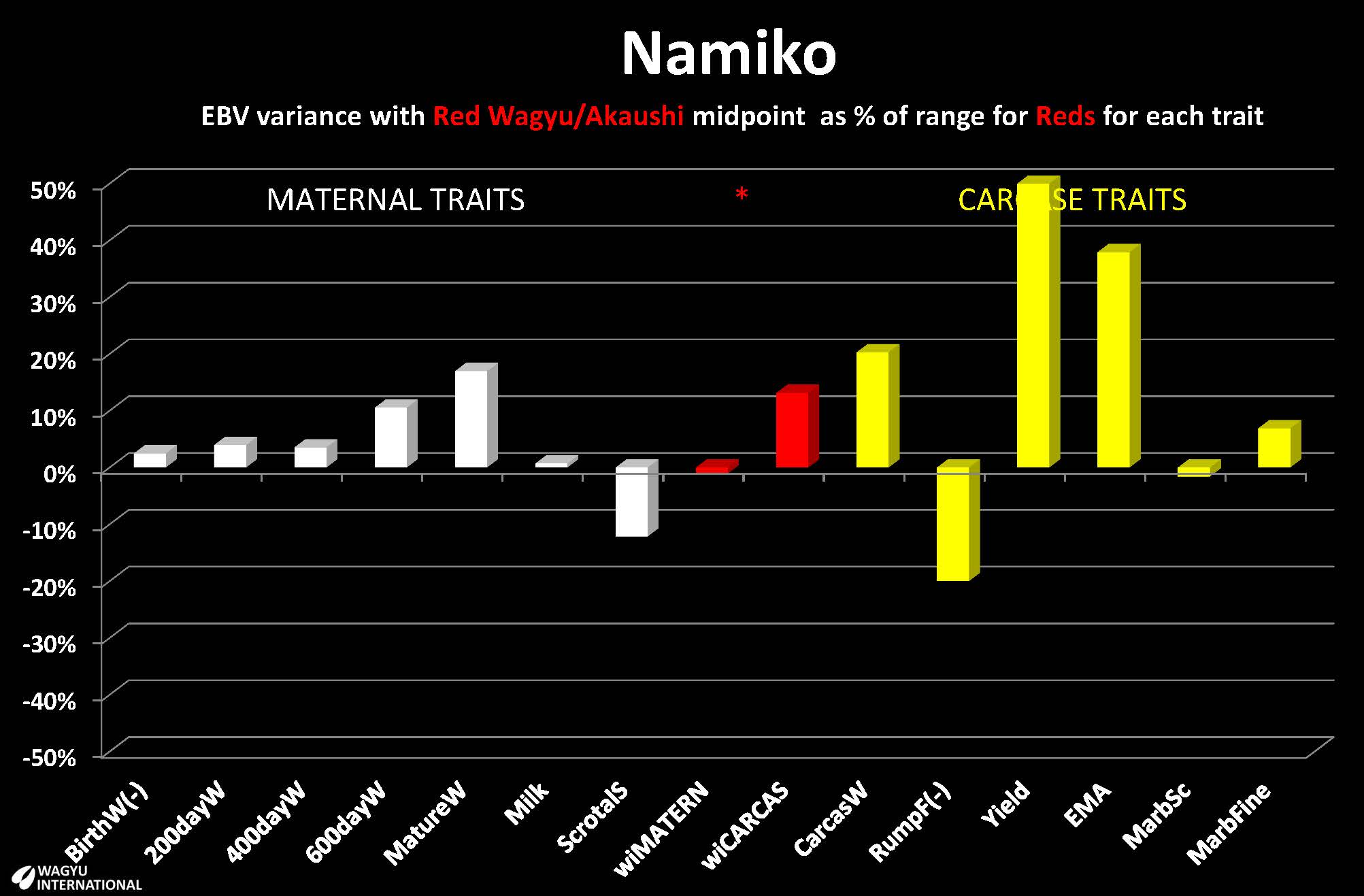
The accuracy of EBVs is very low in the Red Wagyu/Akaushi population. Selection had been made on growth and size for such a long period thatit is possible that the proportion of traditional Wagyu genetics is much longer than in the Black Wagyu herd where selection for carcass quality was applied for a longer period. This variable pool of foreign DNA may have some influence together with the low amount of performance data. Even when progeny carcass data has been analysed in BREEDPLAN, the accuracy of traits from those sires remains disappointingly low. Nevertheless, the BLUP analysis is a good way to start with when performance data is available for the analysis of breeding value
Finally, to put the Red Wagyu animals in perspective, the exceptional breeding merit attributed to popular Australian Red Wagyu/Akaushi sire, Ashwood X014 is illustrated below firstly on the left when his EBVs are ranked against the Red Wagyu/Akaushi population. On the right, his EBVs are ranked against the BREEDPLAN population in BREEDPLAN:
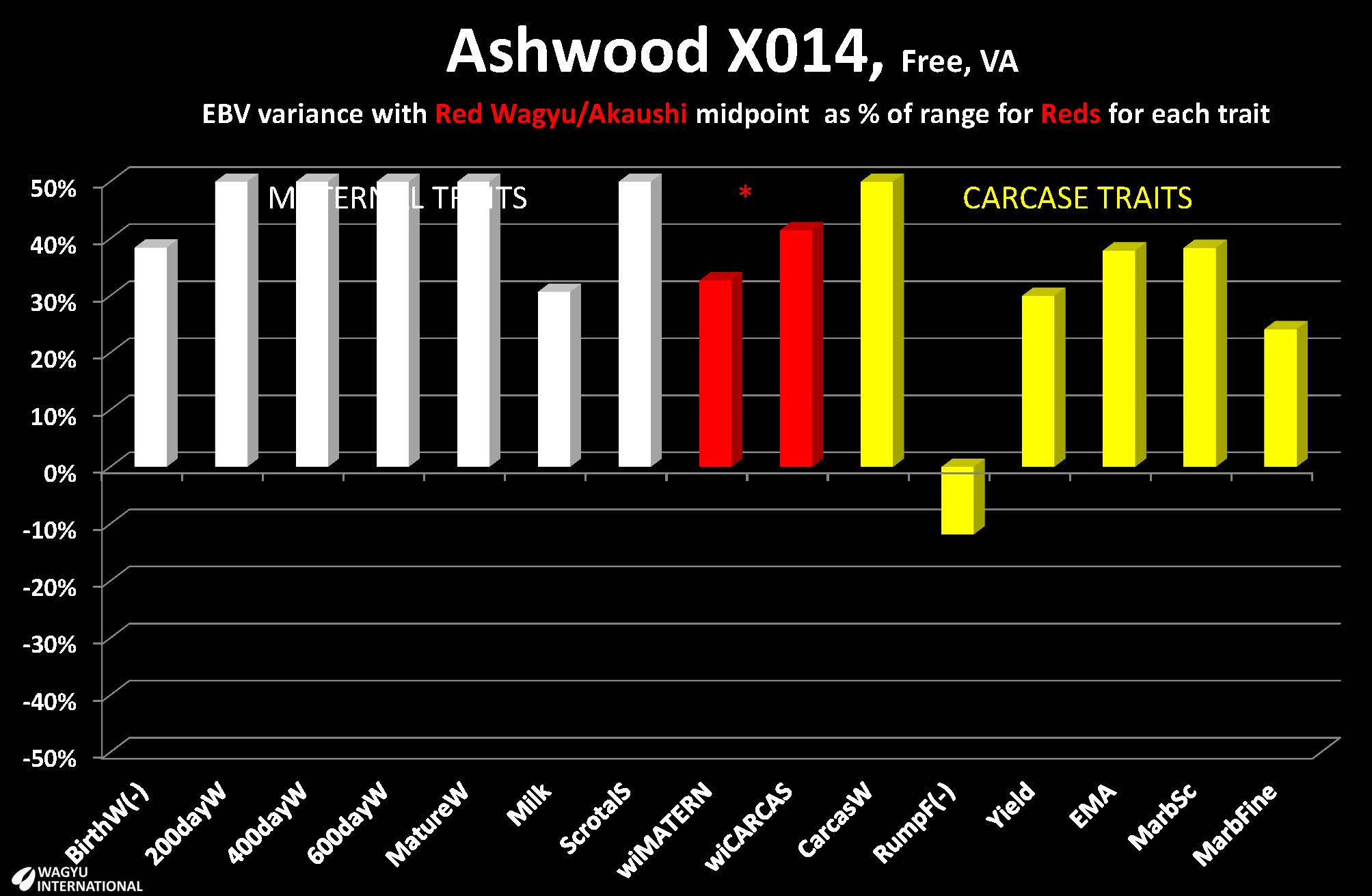
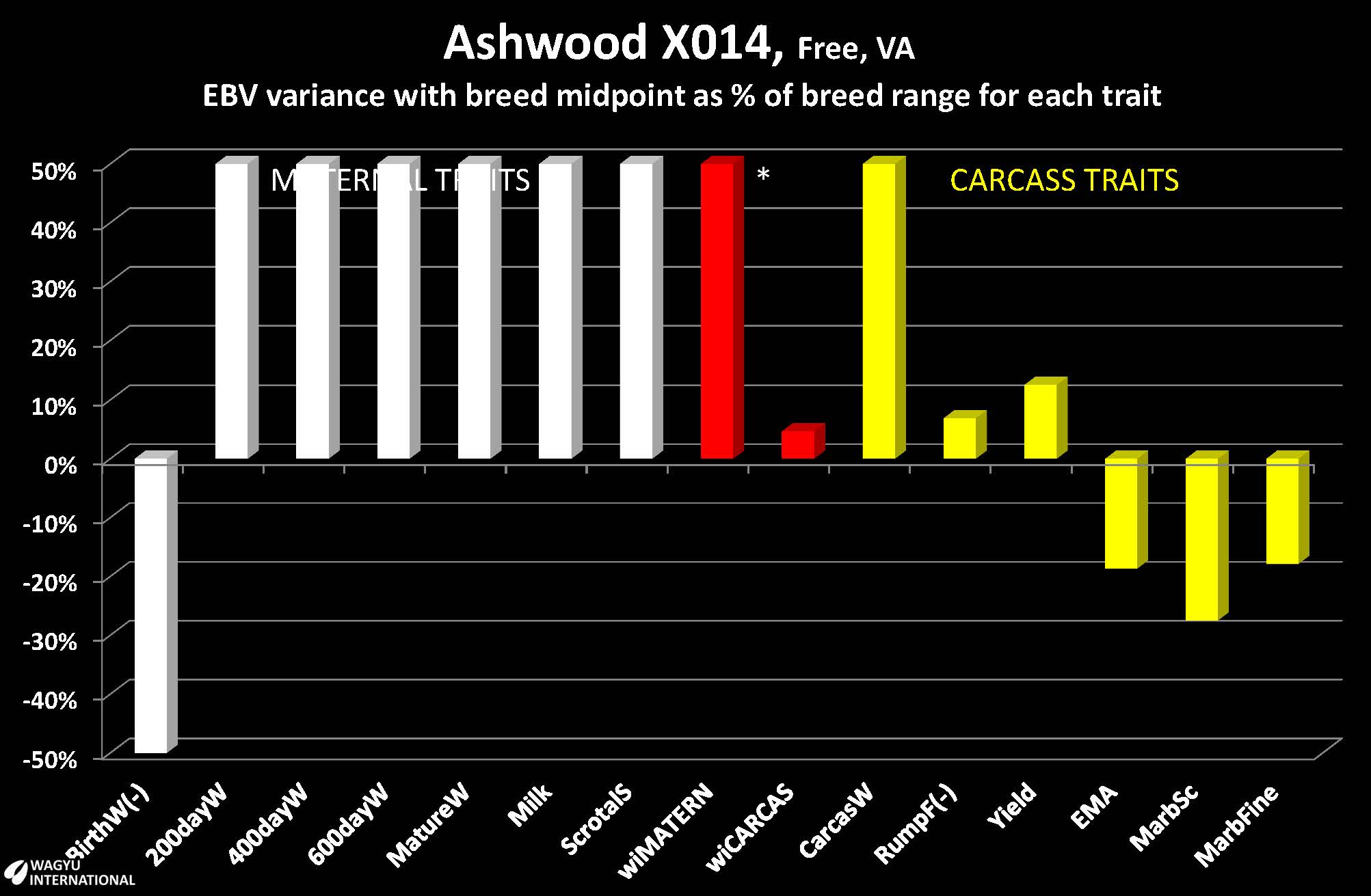
Ashwood X014 is +35% for Marble Score when his Marble Score EBV of +0.2 from 5 carcass progeny is ranked amongst Red Wagyu/Akaushi, but he is -35% for Marble Score when ranked with the overall Wagyu population. The average for Marble Score is +0.7.
Recessive conditions
The status of genetic disorders in Foundation animals are presented in these tables:
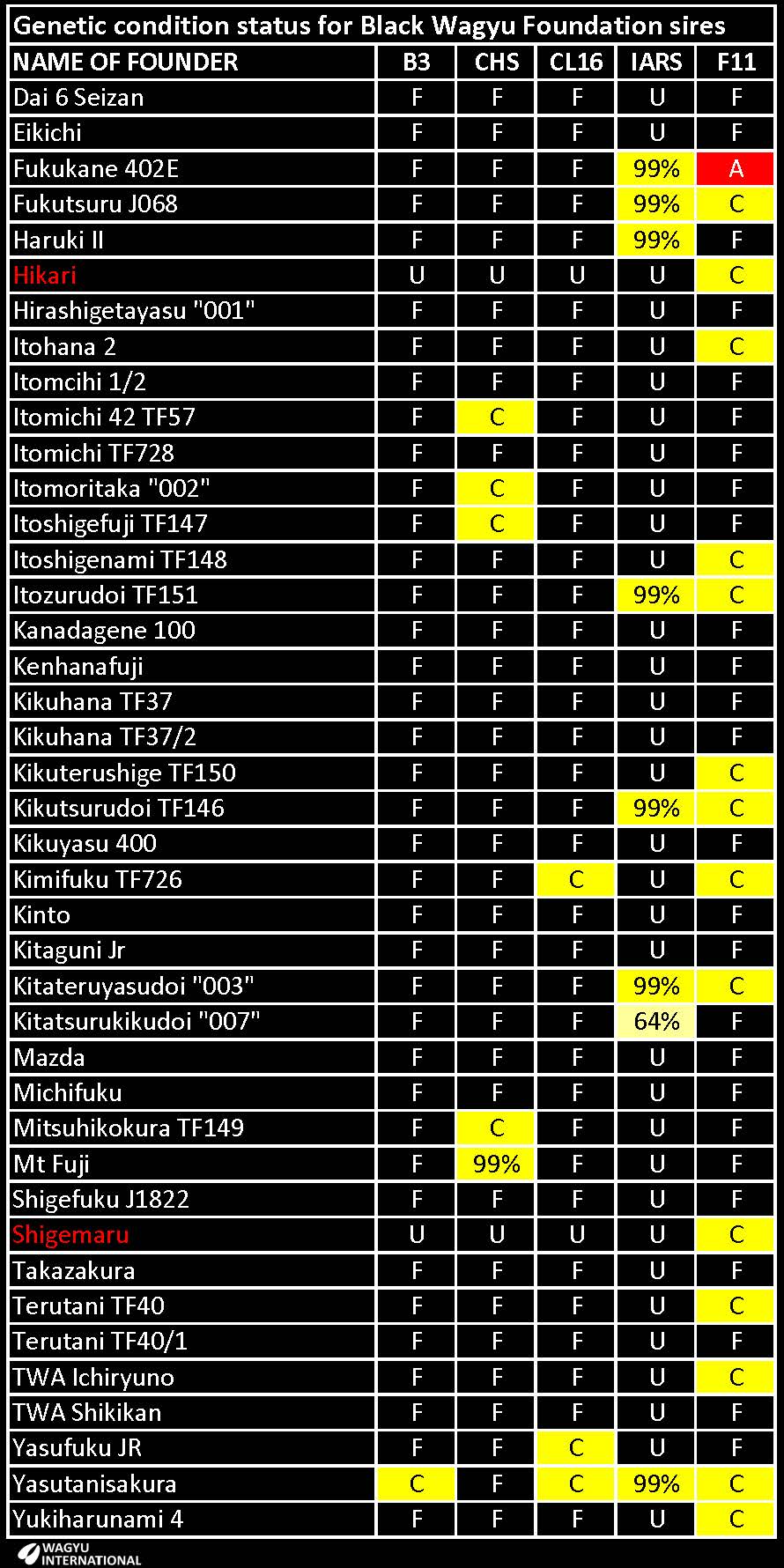
A - Determined to be homozygous Affected with two mutant genes from testing.
C - Determined to be heterozygote Carrier with one mutant gene from testing.
F - Tested to be free.
U - Untested, but based on pedigree is expected to be free.
% - The chance that an animal may be a carrier. Untested, but based on pedigree. The higher the percentage, the higher the probability that the animal is a carrier. 99% probability is the maximum.
The probability that the following Foundations have recessive conditions is tabled:
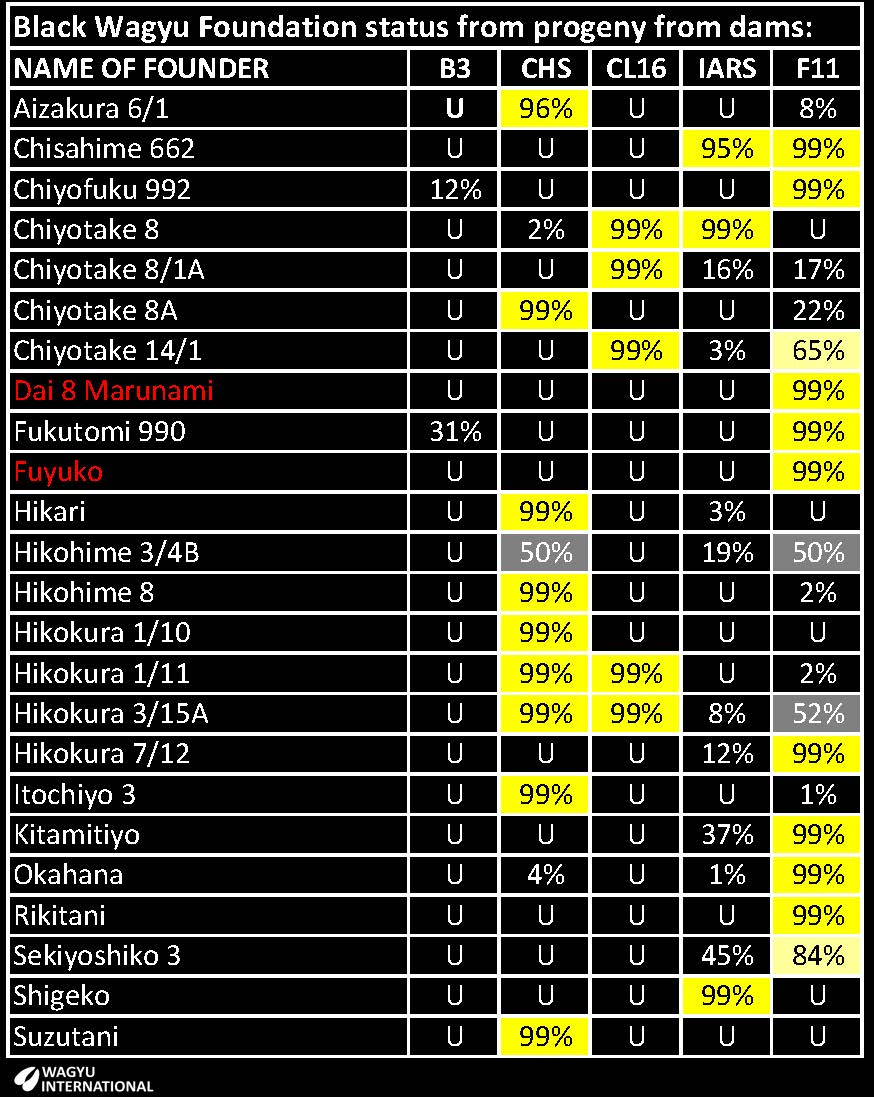
Disclaimer
Wagyu International provides information that has been supplied by other parties and gives no warranty (express or implied) as to the data completeness, accuracy or fitness for a particular purpose.
Please inform the webmaster if recent test results have been obtained.
References
American Wagyu Association database registrations
Australian Wagyu Association database registrations
Crescent Harbor Ranch history webpage
Ken Tew communications
Wagyu Sekai history webpage
Acknowledgement is given to communications with, and materials supplied, by Sumo Cattle Co and Wagyu Sekei
DISCLAIMER Wagyu International provides information that has been supplied by other parties and gives no warranty (express or implied) as to the data completeness, accuracy or fitness for a particular purpose.
